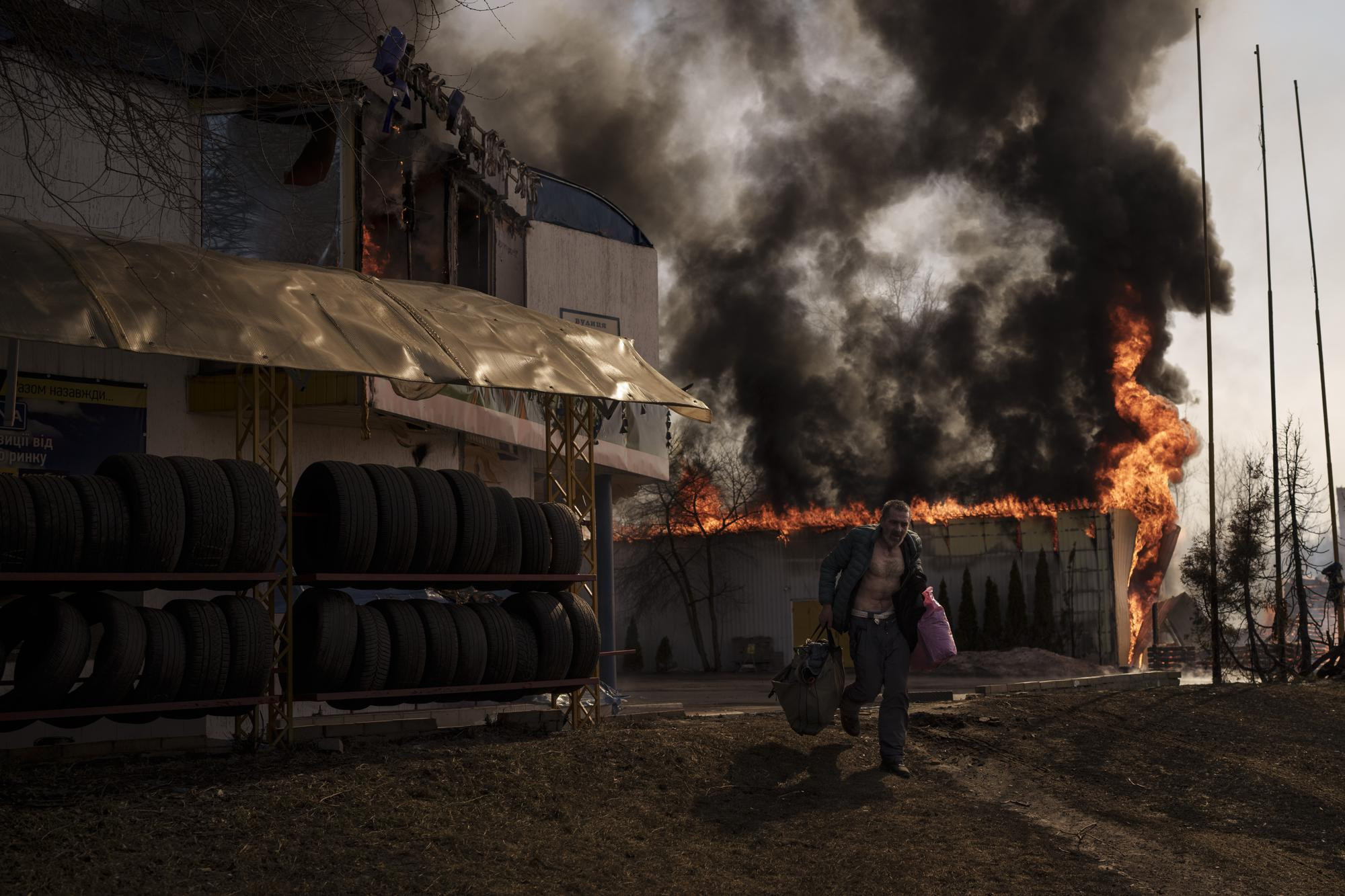How many buildings have been obliterated in Ukraine? How many limbs lost, children brutalized, refugees put to flight? How many mothers and fathers, sons and daughters killed in 100 days?
How many dreams have been destroyed?
There is no accounting of a war that launched in late winter, continued through spring and is likely to drag on for seasons to come. The conflict unleashed by Russian President Vladimir Putin defies statistics. It is a story best told in unsparing images of human suffering and resilience.
In the war’s 100 days, Associated Press photographers have captured the terror -- people diving to the floor of a Mariupol hospital as bombs fall around them; a mob of refugees, huddled under a bridge. They have captured the tears of grieving survivors, and of families separated by the war.
They have shown us the playfulness of a soldier, lightheartedly kicking a ball amid the carnage; of another soldier, leading an impromptu chorale. They have shown us a chilling view of a car driving down a highway, through the sight of a Ukrainian sniper. They have shown us a landscape littered with buildings in ruins and the carcasses of Russian tanks.
And so many bodies. Bodies in trenches and half-buried in hillsides and arrayed on pavements and lying in pools of blood and carried in coffins. A soldier spread out like a statue in a Christ-like pose on a metal barrier. An arm extended in the dirt.
This is a country that has been transformed in the blink of an eye. A hundred days ago, a bathtub was for bathing; now, it is a place where a little girl and her dog hide from bombs.
What will it be like, 100 days from now?
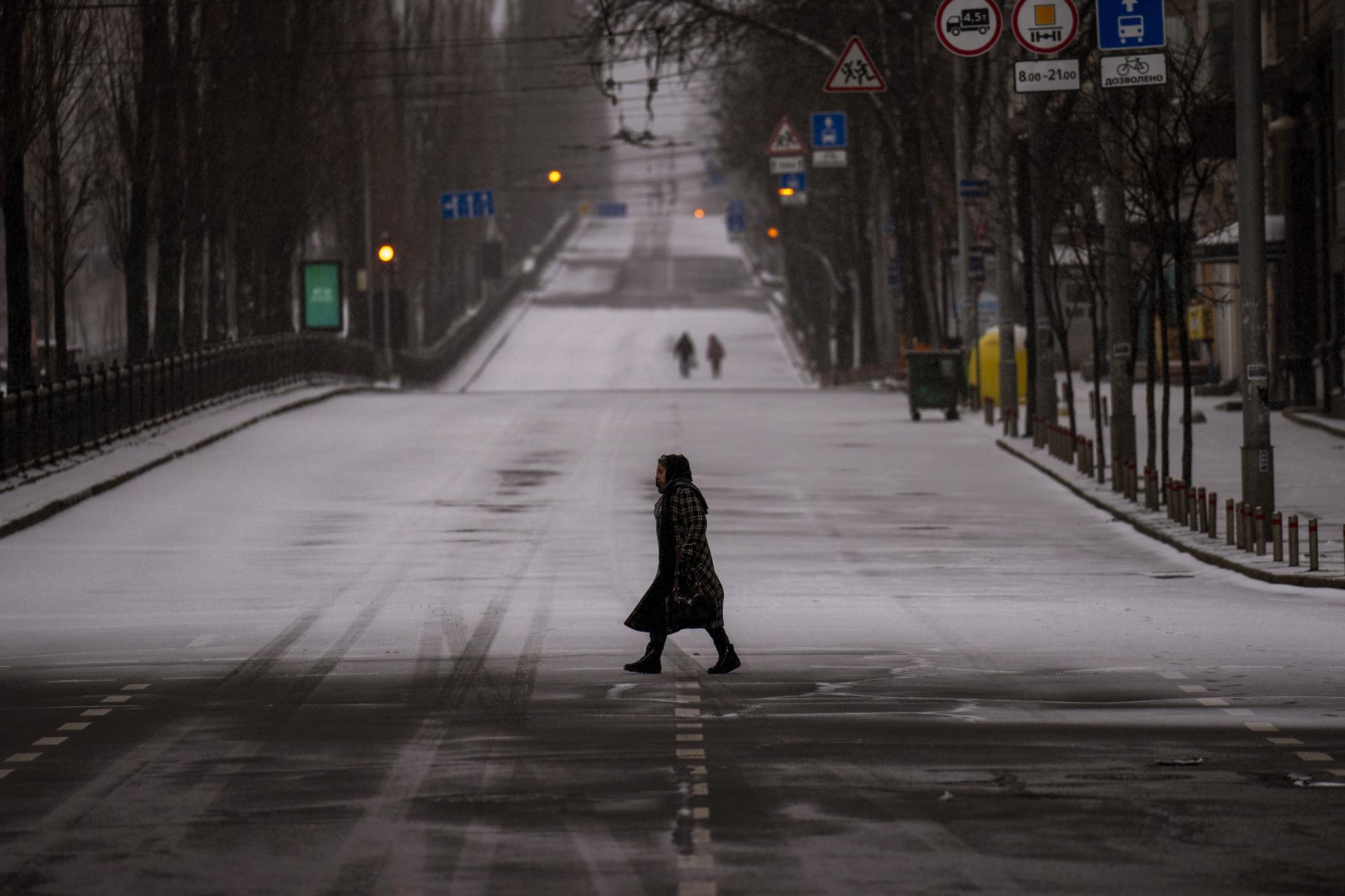 Roads are empty during curfew in Kyiv, Ukraine, Tuesday, March 1, 2022. (AP Photo/Emilio Morenatti)
Roads are empty during curfew in Kyiv, Ukraine, Tuesday, March 1, 2022. (AP Photo/Emilio Morenatti)
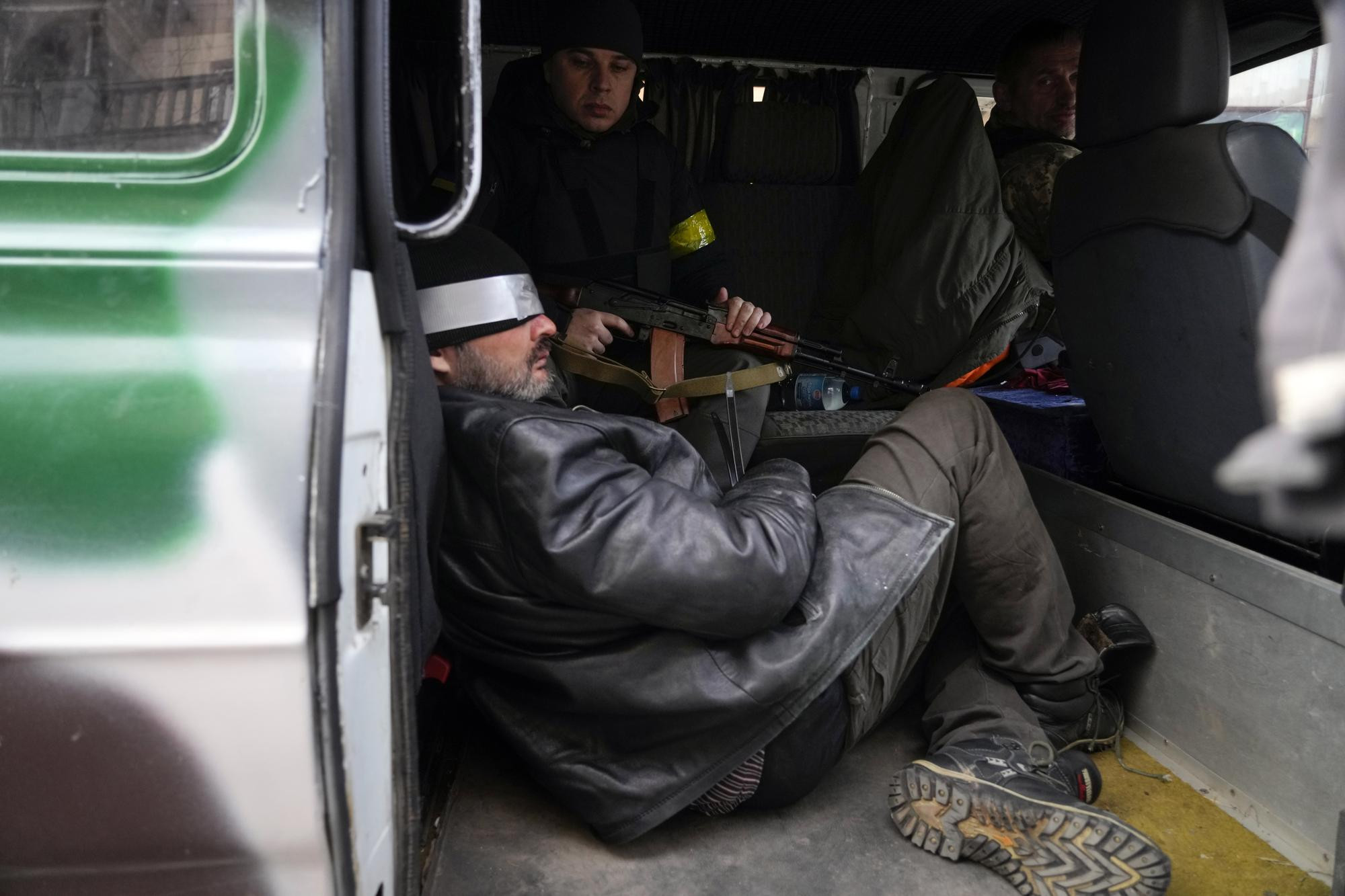 Ukrainian troops escort a suspected Russian agent in Kyiv, Ukraine, Sunday, Feb. 27, 2022. (AP Photo/Efrem Lukatsky)
Ukrainian troops escort a suspected Russian agent in Kyiv, Ukraine, Sunday, Feb. 27, 2022. (AP Photo/Efrem Lukatsky)
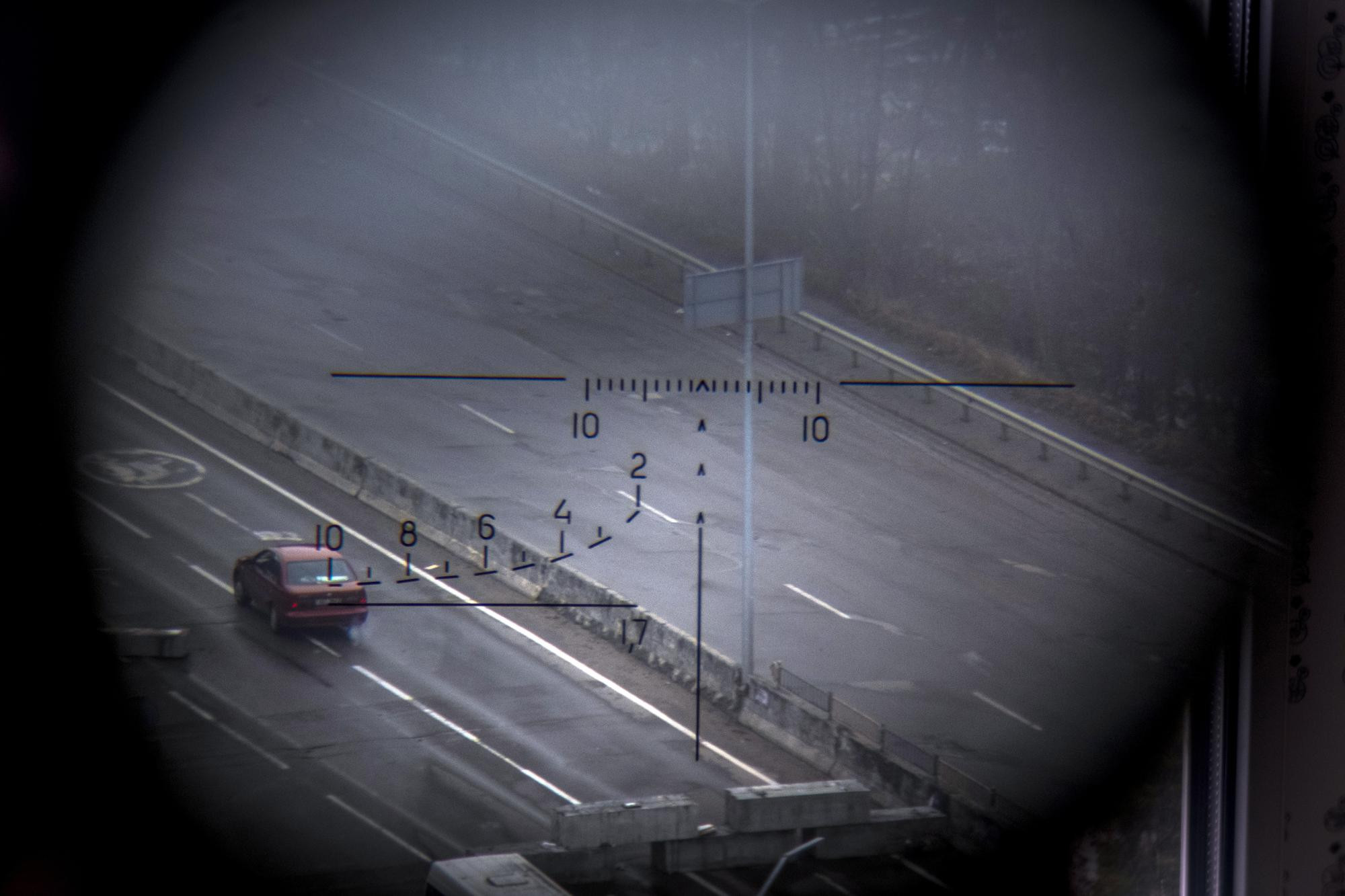 A moving car is visible through the viewfinder of a Dragunov sniper rifle, from a Ukrainian army position in the northern part of Kyiv, Ukraine, Tuesday, March 1, 2022. The Dragunov was created by the Soviet Union in the 1960s. (AP Photo/Ricard Garcia Vilanova)
A moving car is visible through the viewfinder of a Dragunov sniper rifle, from a Ukrainian army position in the northern part of Kyiv, Ukraine, Tuesday, March 1, 2022. The Dragunov was created by the Soviet Union in the 1960s. (AP Photo/Ricard Garcia Vilanova)
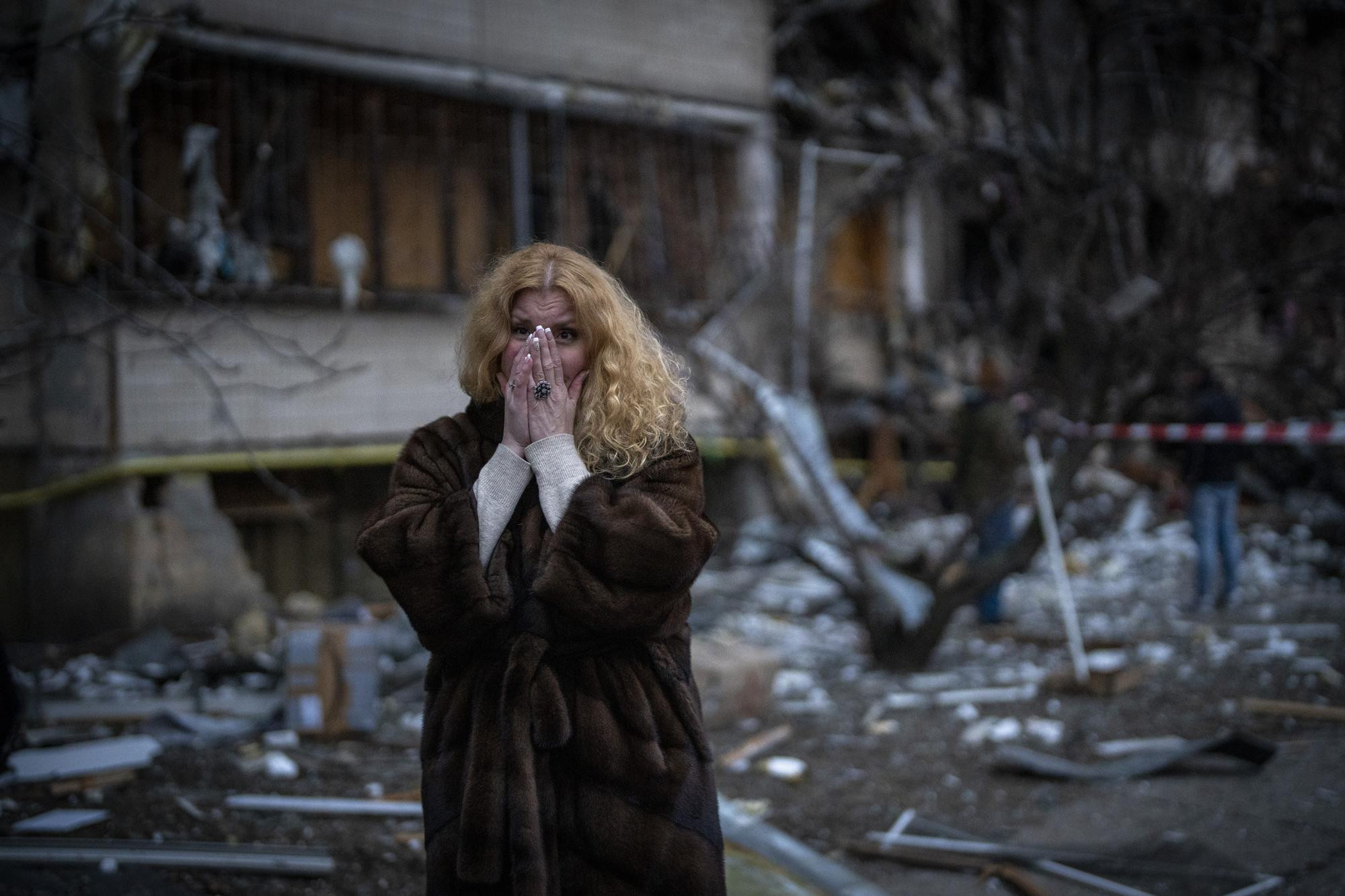 Natali Sevriukova stands near her house after a rocket attack in Kyiv, Ukraine, Friday, Feb. 25, 2022. (AP Photo/Emilio Morenatti)
Natali Sevriukova stands near her house after a rocket attack in Kyiv, Ukraine, Friday, Feb. 25, 2022. (AP Photo/Emilio Morenatti)
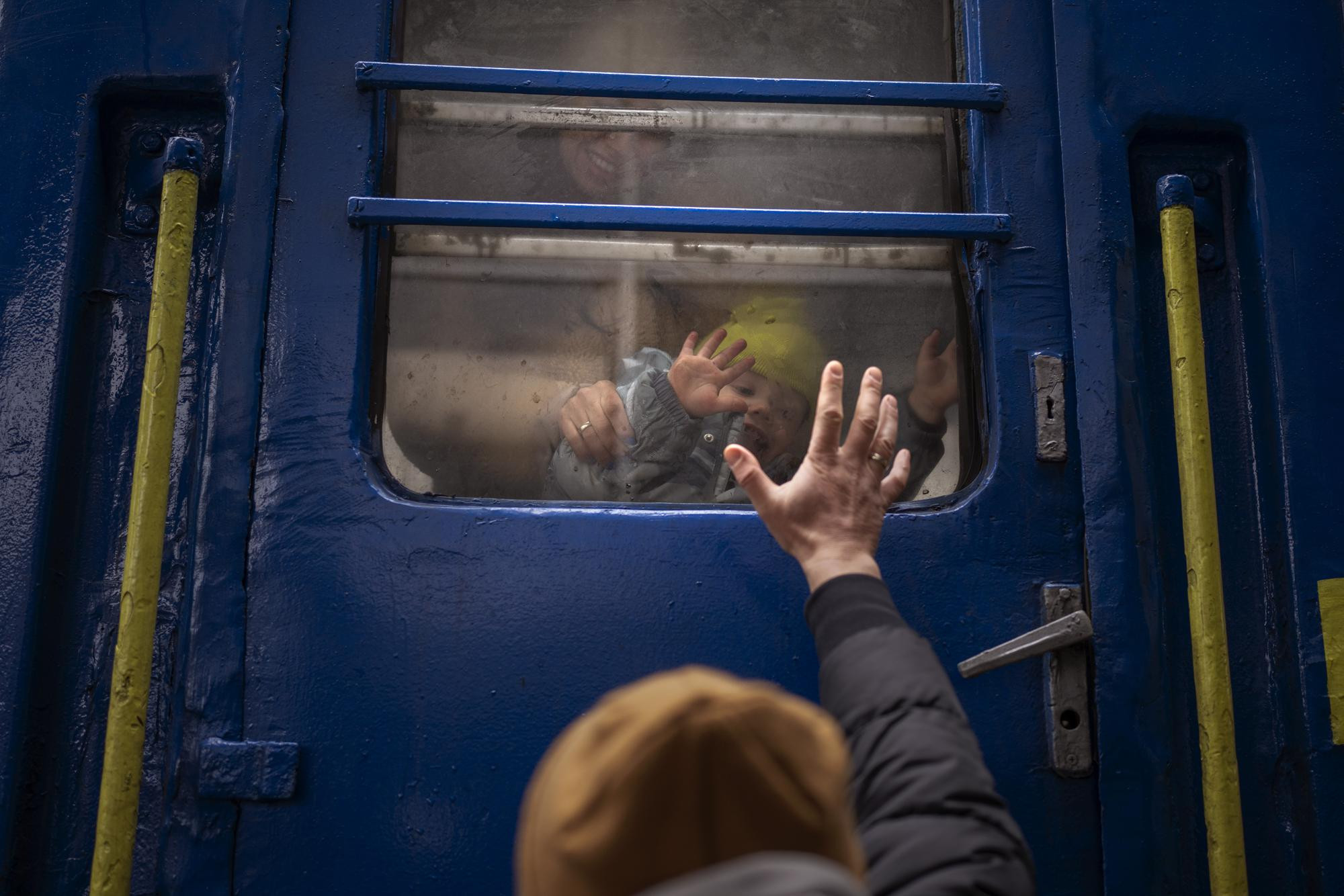 Stanislav says goodbye to his two-year-old son David and wife Anna after they boarded a train that will take them to Lviv, from the station in Kyiv, Ukraine, Thursday, March 3. 2022. Stanislav stayed to fight as his family sought refuge in a neighboring country. (AP Photo/Emilio Morenatti)
Stanislav says goodbye to his two-year-old son David and wife Anna after they boarded a train that will take them to Lviv, from the station in Kyiv, Ukraine, Thursday, March 3. 2022. Stanislav stayed to fight as his family sought refuge in a neighboring country. (AP Photo/Emilio Morenatti)
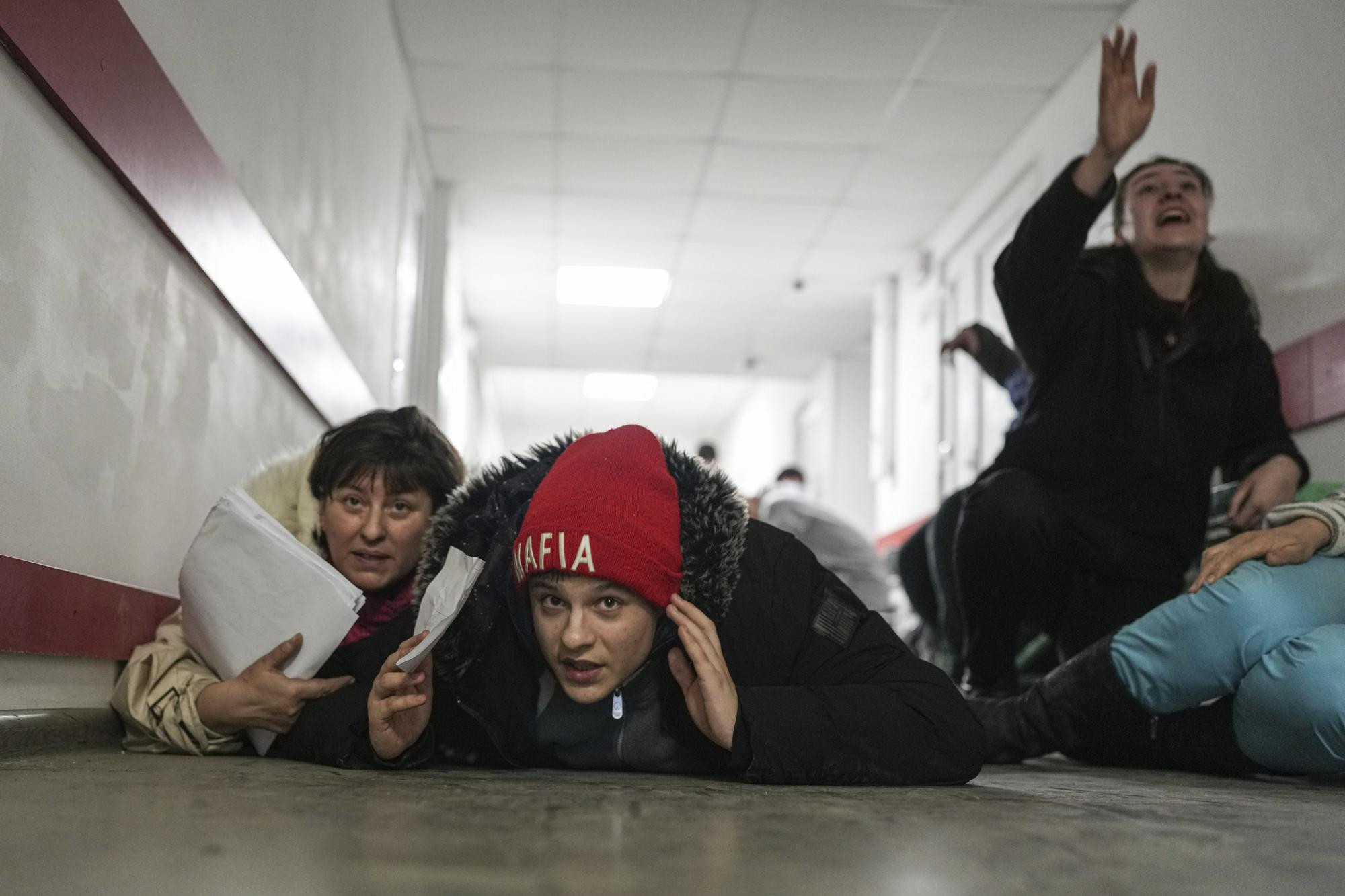 People take cover on the floor of a hospital during shelling by Russian forces in Mariupol, Ukraine, Friday, March 4, 2022. (AP Photo/Evgeniy Maloletka)
People take cover on the floor of a hospital during shelling by Russian forces in Mariupol, Ukraine, Friday, March 4, 2022. (AP Photo/Evgeniy Maloletka)
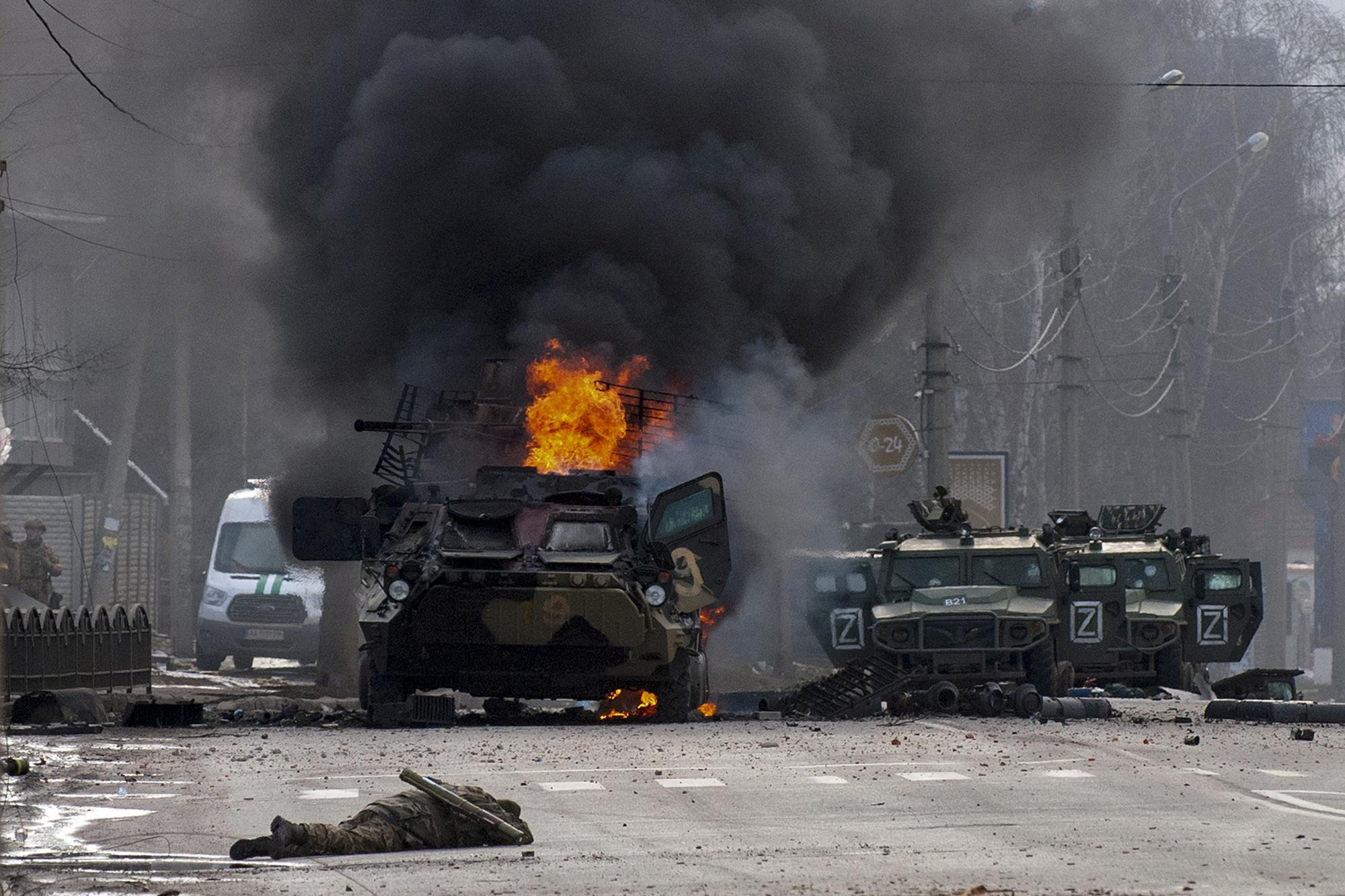 A Russian armored personnel carrier burns amid damaged and abandoned light utility vehicles after fighting in Kharkiv, Ukraine, Sunday, Feb. 27, 2022. (AP Photo/Marienko Andrew)
A Russian armored personnel carrier burns amid damaged and abandoned light utility vehicles after fighting in Kharkiv, Ukraine, Sunday, Feb. 27, 2022. (AP Photo/Marienko Andrew)
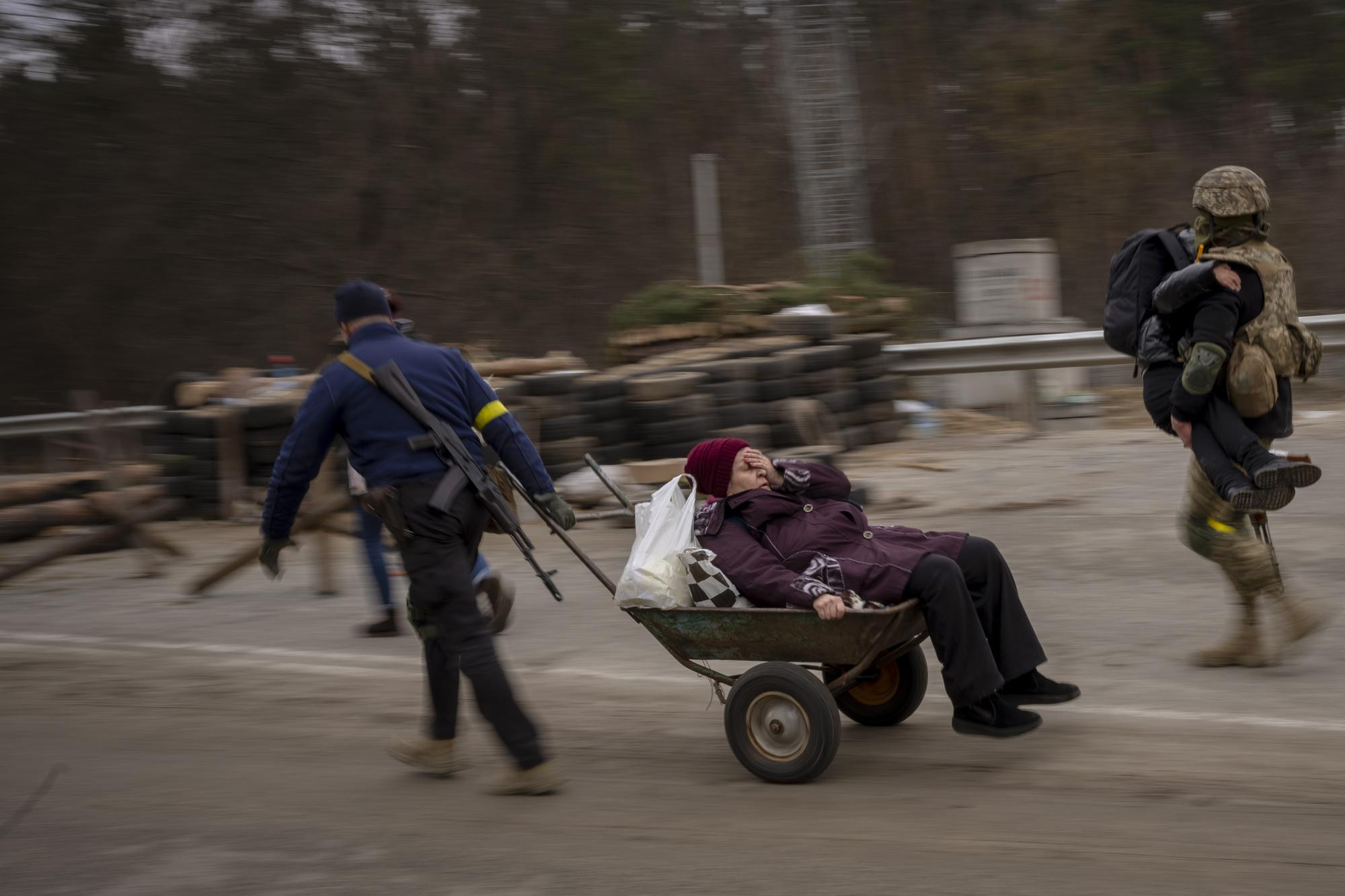 A Ukrainian soldier and a militia man help a fleeing family to cross the Irpin River on the outskirts of Kyiv, Ukraine, Saturday, March 5, 2022. (AP Photo/Emilio Morenatti)
A Ukrainian soldier and a militia man help a fleeing family to cross the Irpin River on the outskirts of Kyiv, Ukraine, Saturday, March 5, 2022. (AP Photo/Emilio Morenatti)
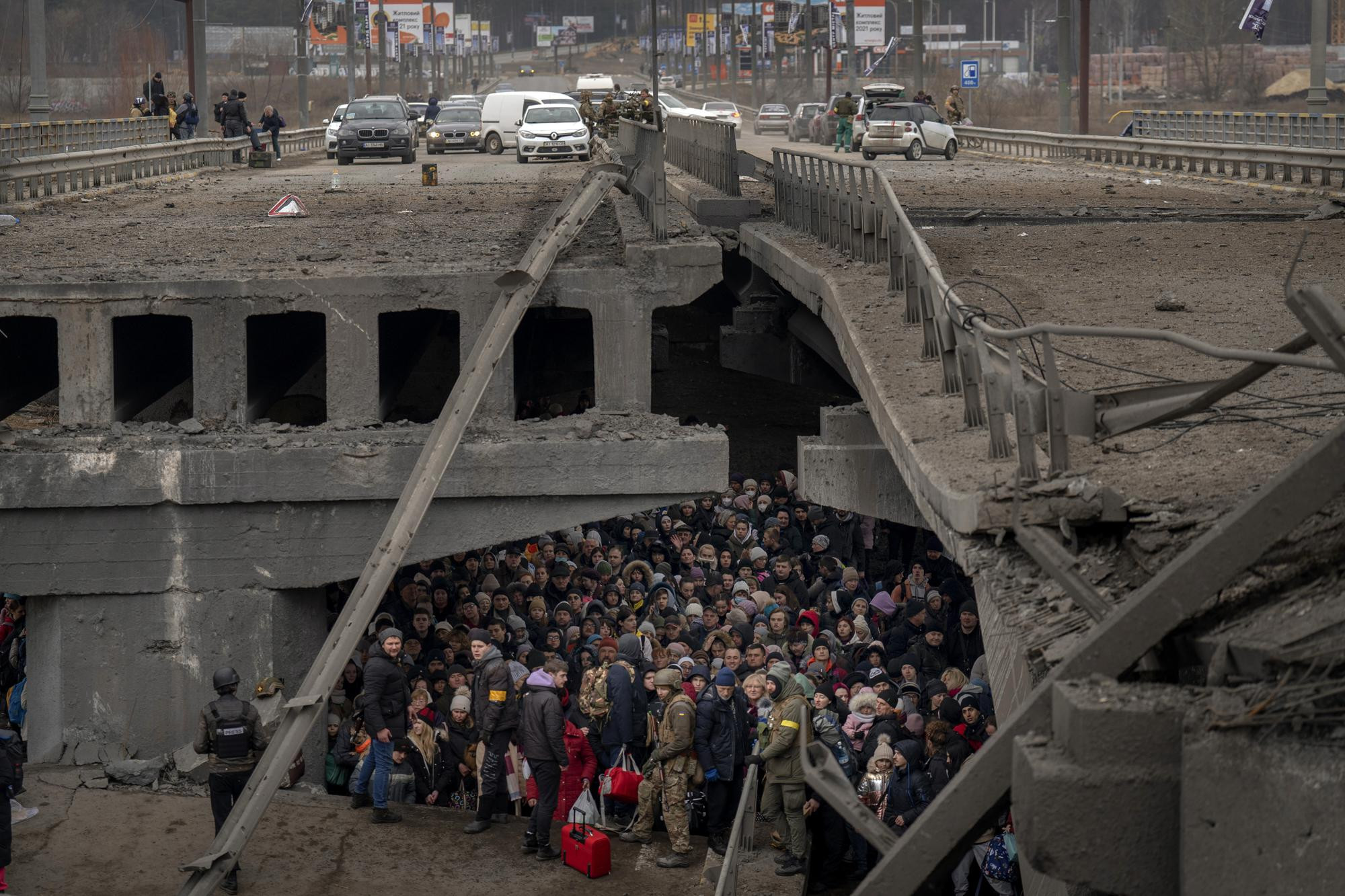 Ukrainians crowd under a destroyed bridge as they try to flee by crossing the Irpin River on the outskirts of Kyiv, Ukraine, Saturday, March 5, 2022. (AP Photo/Emilio Morenatti)
Ukrainians crowd under a destroyed bridge as they try to flee by crossing the Irpin River on the outskirts of Kyiv, Ukraine, Saturday, March 5, 2022. (AP Photo/Emilio Morenatti)
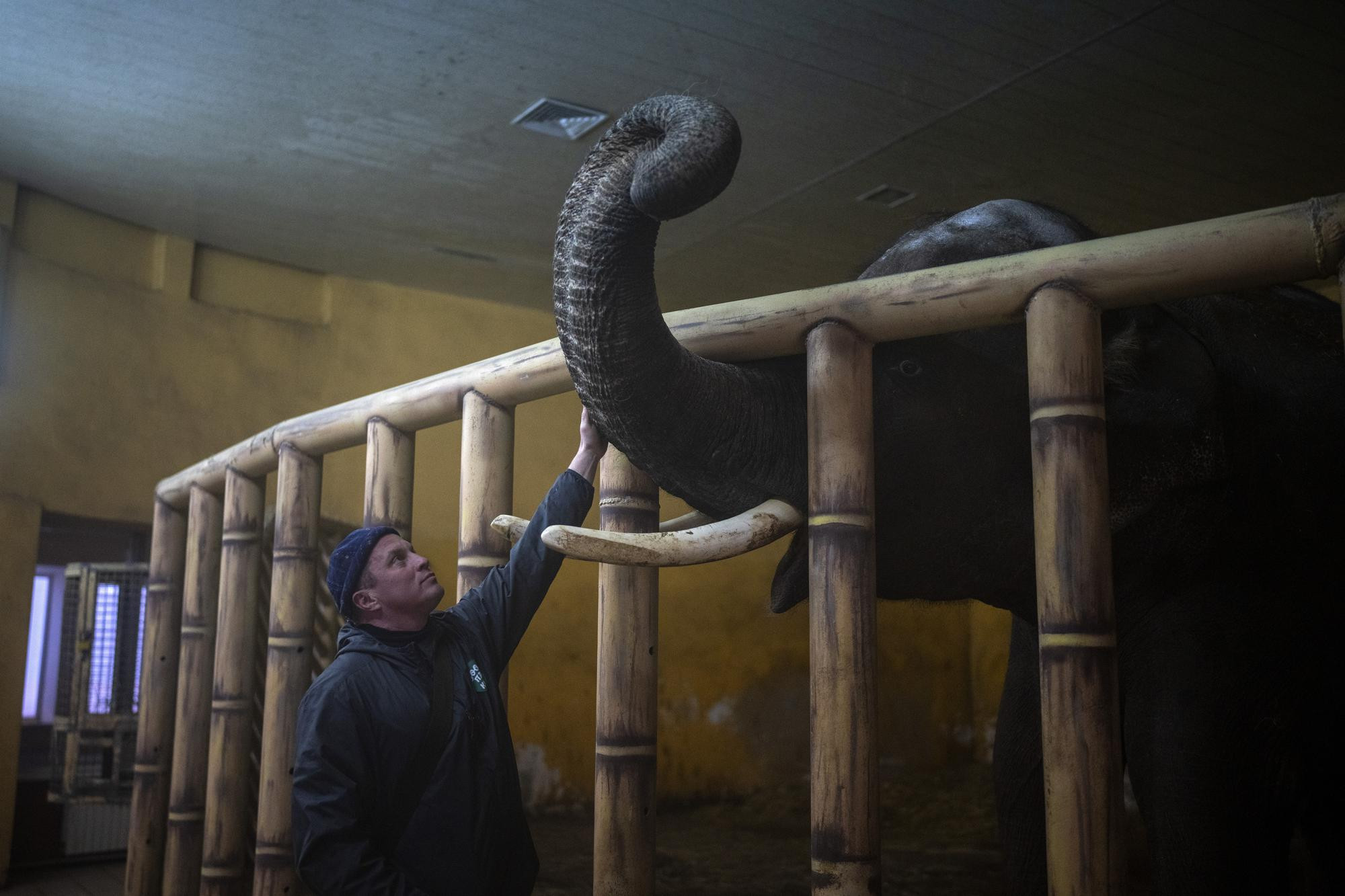 Animal keeper Kirilo Trantin comforts an elephant at the Kiev Zoo in Kyiv, Ukraine, Tuesday, March 1. 2022. (AP Photo/Emilio Morenatti)
Animal keeper Kirilo Trantin comforts an elephant at the Kiev Zoo in Kyiv, Ukraine, Tuesday, March 1. 2022. (AP Photo/Emilio Morenatti)
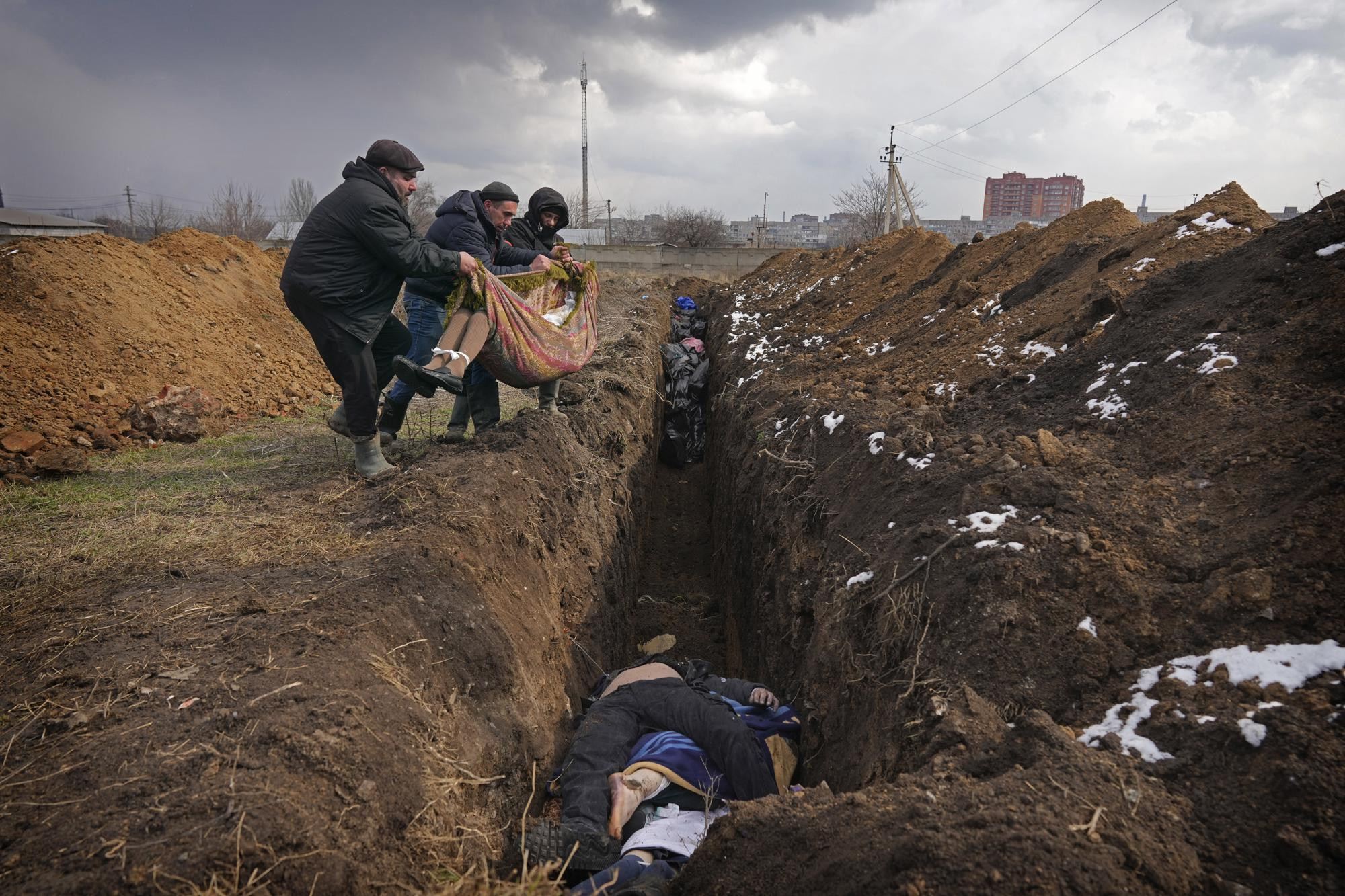 Bodies are placed into a mass grave on the outskirts of Mariupol, Ukraine, Wednesday, March 9, 2022. (AP Photo/Evgeniy Maloletka)
Bodies are placed into a mass grave on the outskirts of Mariupol, Ukraine, Wednesday, March 9, 2022. (AP Photo/Evgeniy Maloletka)
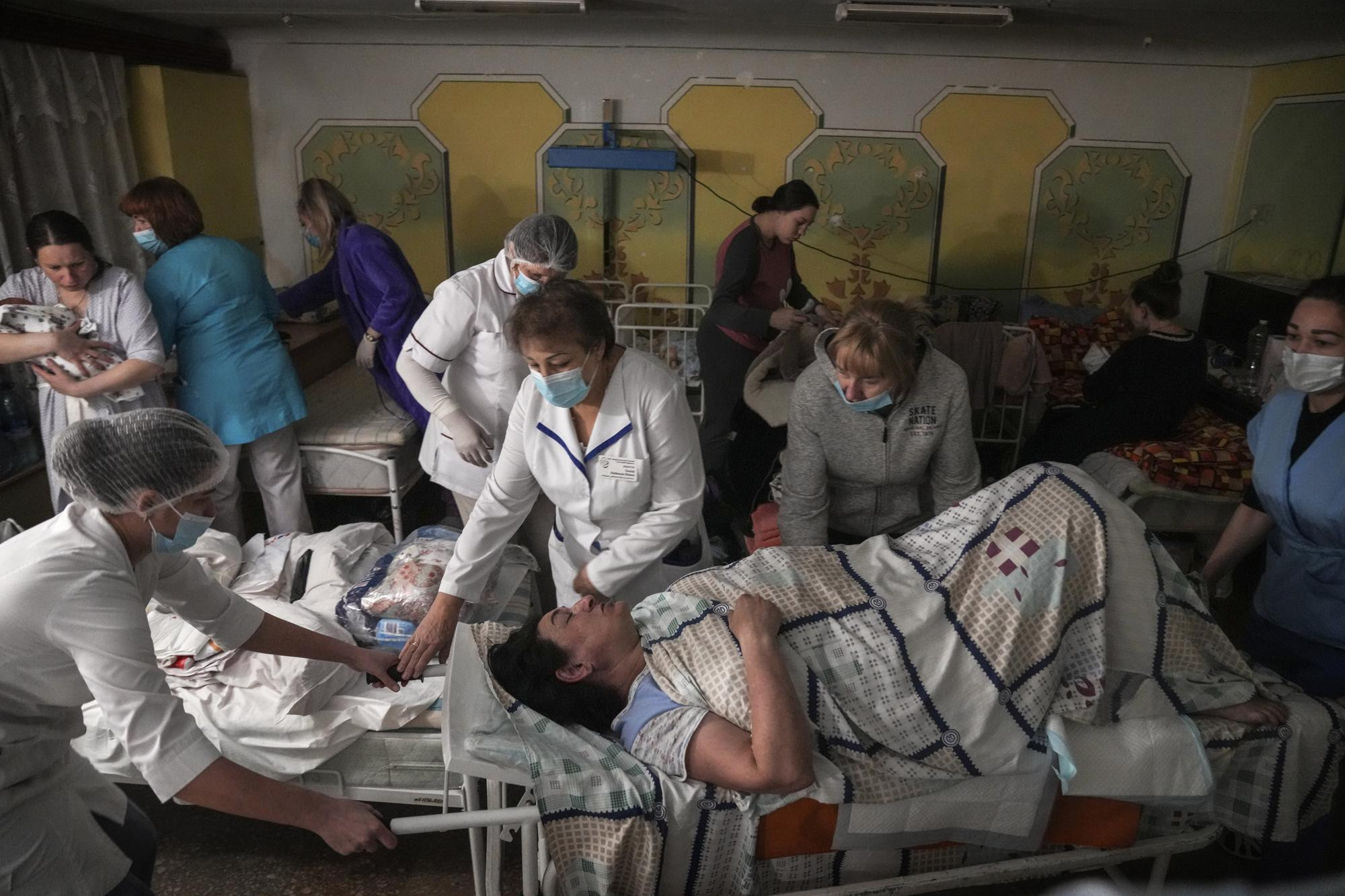 Medical workers move a patient in the basement of a maternity hospital that has been converted into a medical ward and bomb shelter in Mariupol, Ukraine, Tuesday, March 1, 2022. (AP Photo/Evgeniy Maloletka)
Medical workers move a patient in the basement of a maternity hospital that has been converted into a medical ward and bomb shelter in Mariupol, Ukraine, Tuesday, March 1, 2022. (AP Photo/Evgeniy Maloletka)
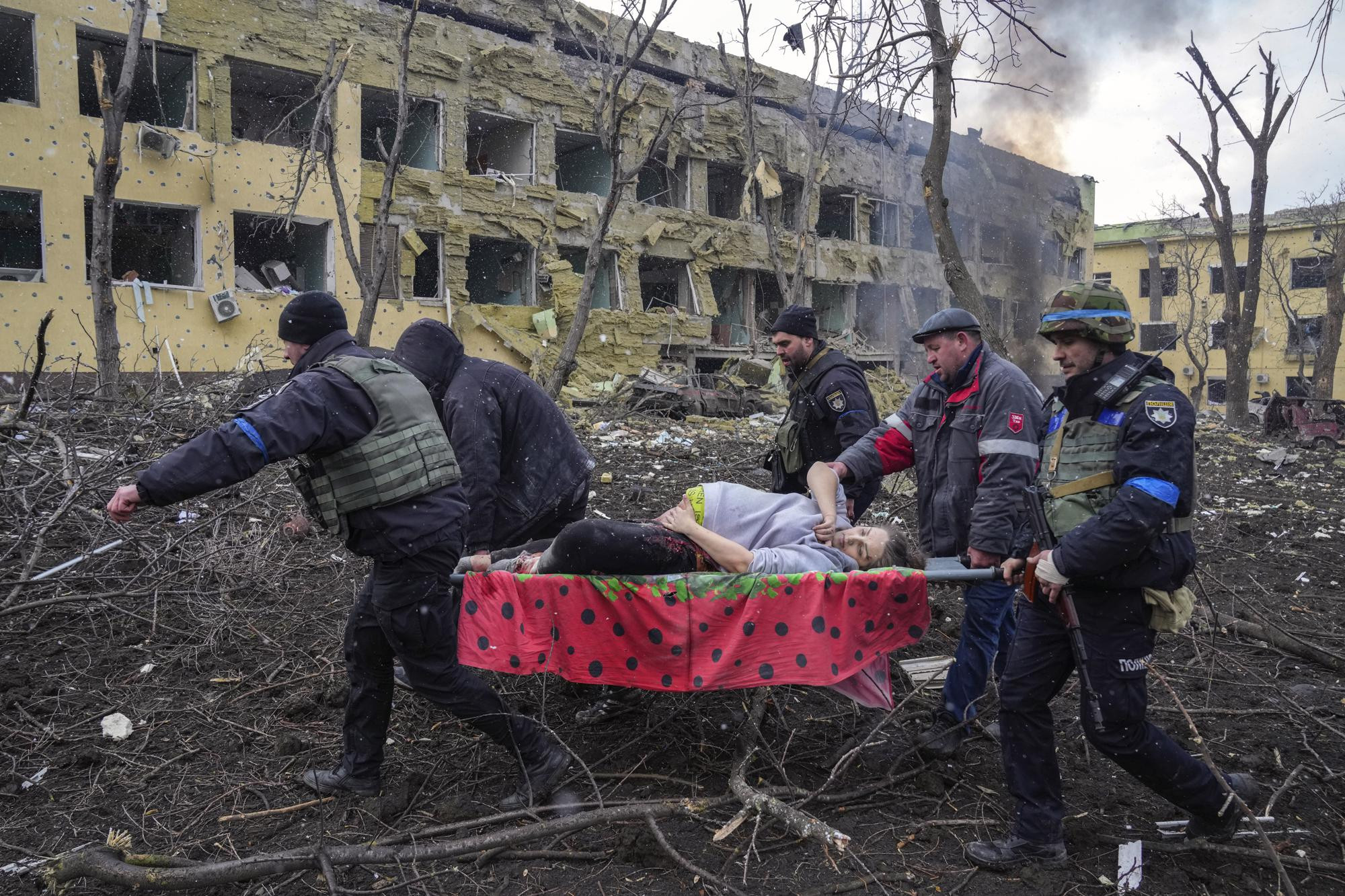 A pregnant woman whose pelvis had been crushed and her hip detached during Russian shelling is evacuated from a maternity in Mariupol, Ukraine, March 9, 2022. The woman was taken to another hospital closer to the front line but did not survive. (AP Photo/Evgeniy Maloletka)
A pregnant woman whose pelvis had been crushed and her hip detached during Russian shelling is evacuated from a maternity in Mariupol, Ukraine, March 9, 2022. The woman was taken to another hospital closer to the front line but did not survive. (AP Photo/Evgeniy Maloletka)
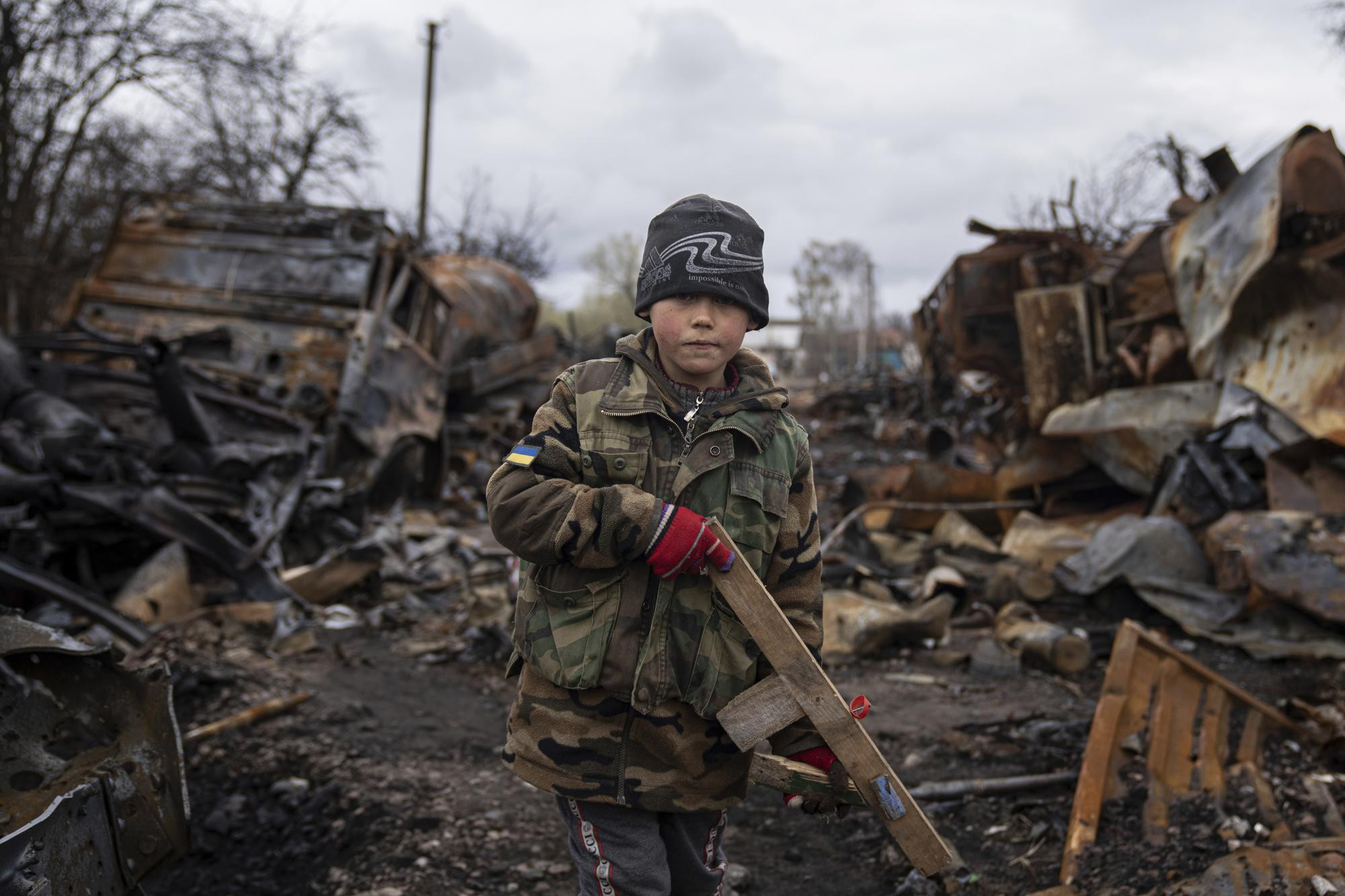 Yehor, 7, holds a toy rifle next to destroyed Russian military vehicles near Chernihiv, Ukraine, Sunday, April 17, 2022. (AP Photo/Evgeniy Maloletka)
Yehor, 7, holds a toy rifle next to destroyed Russian military vehicles near Chernihiv, Ukraine, Sunday, April 17, 2022. (AP Photo/Evgeniy Maloletka)
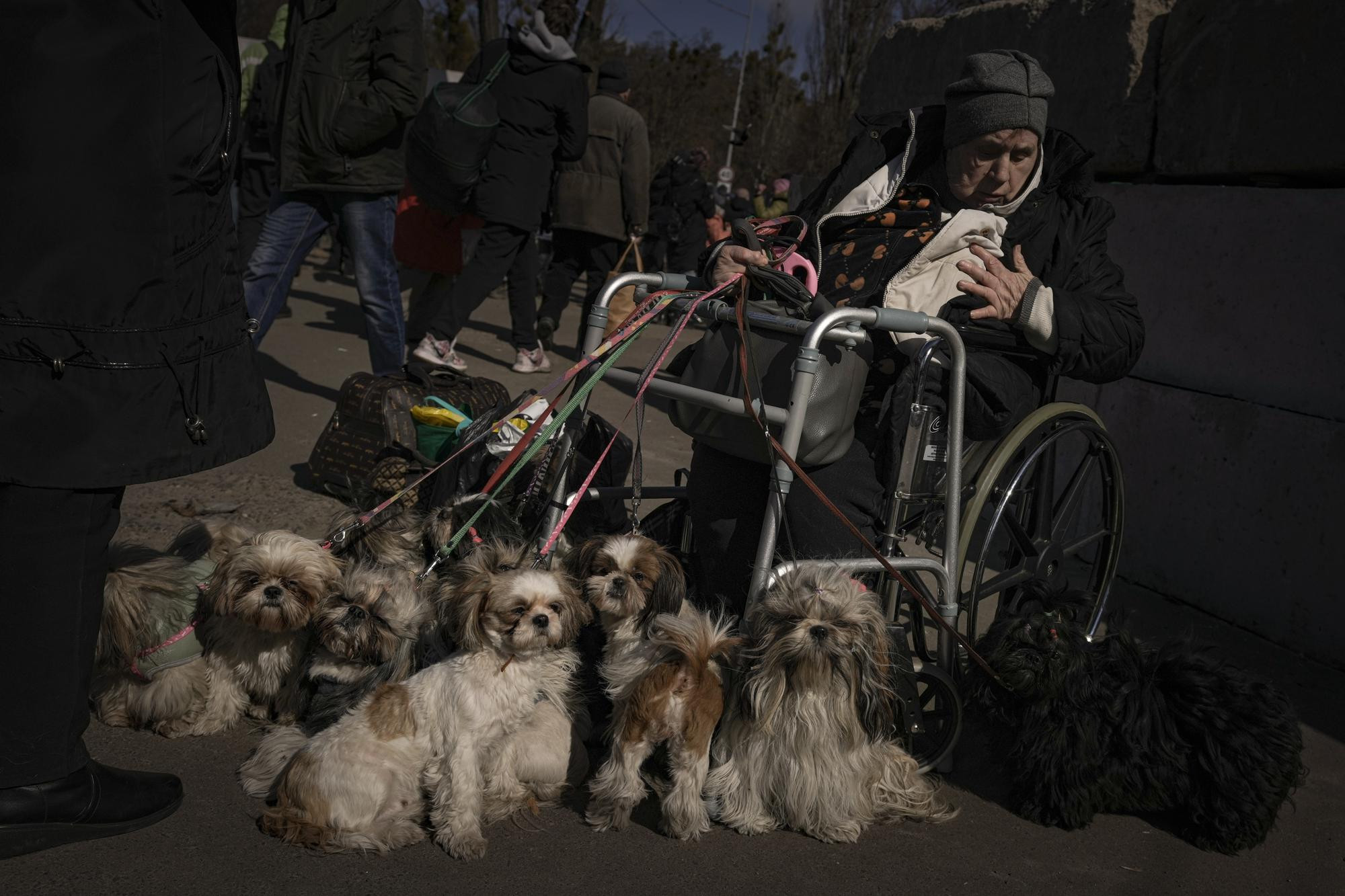 Antonina, 84, sits in a wheelchair after being evacuated with her 12 dogs from Irpin, at a triage point in Kyiv, Ukraine, Friday, March 11, 2022. (AP Photo/Vadim Ghirda)
Antonina, 84, sits in a wheelchair after being evacuated with her 12 dogs from Irpin, at a triage point in Kyiv, Ukraine, Friday, March 11, 2022. (AP Photo/Vadim Ghirda)
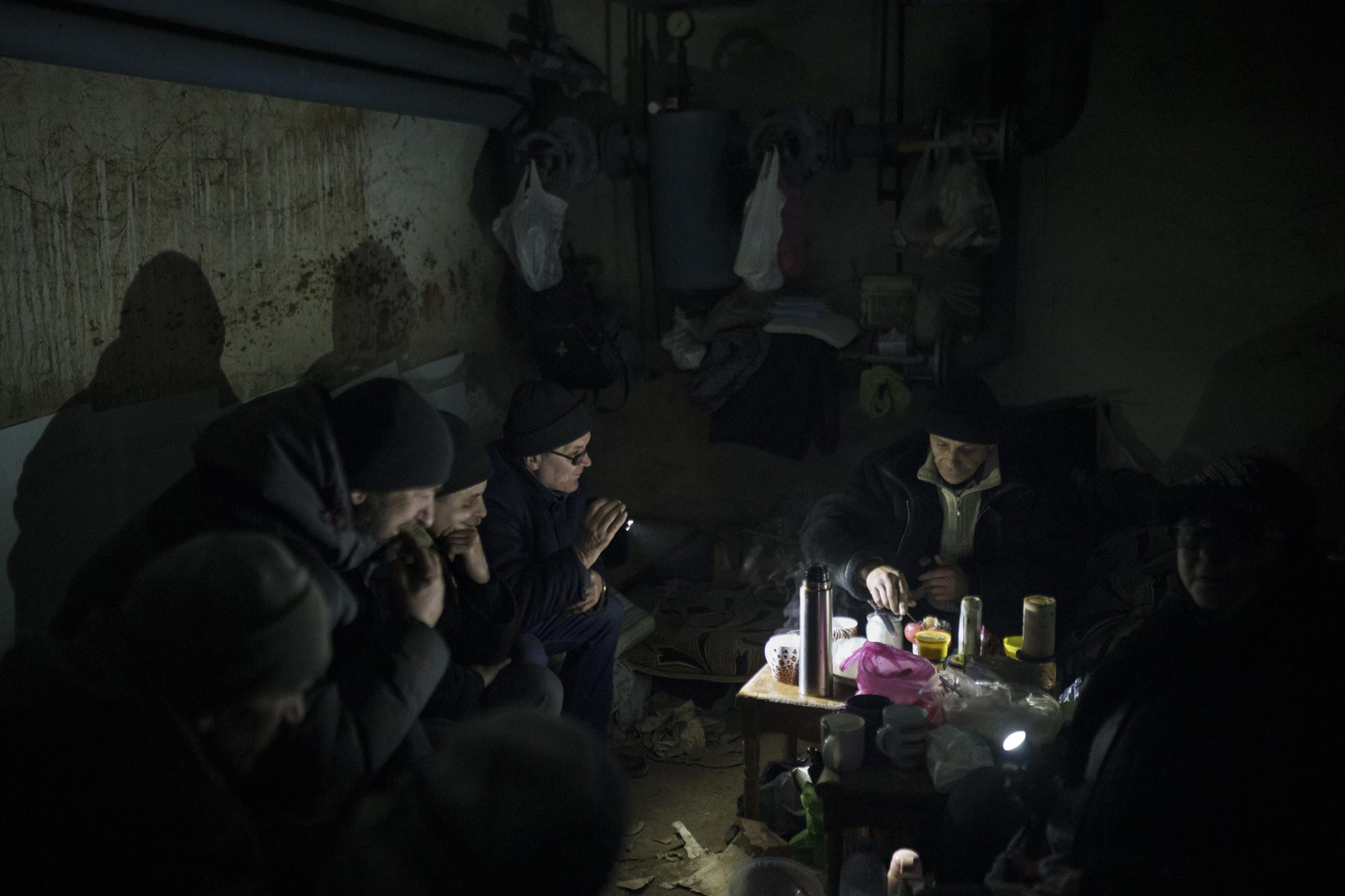 Residents prepare tea in a basement being used as a bomb shelter in Irpin, on the outskirts of Kyiv, Ukraine, Sunday, March 13, 2022. (AP Photo/Felipe Dana)
Residents prepare tea in a basement being used as a bomb shelter in Irpin, on the outskirts of Kyiv, Ukraine, Sunday, March 13, 2022. (AP Photo/Felipe Dana)
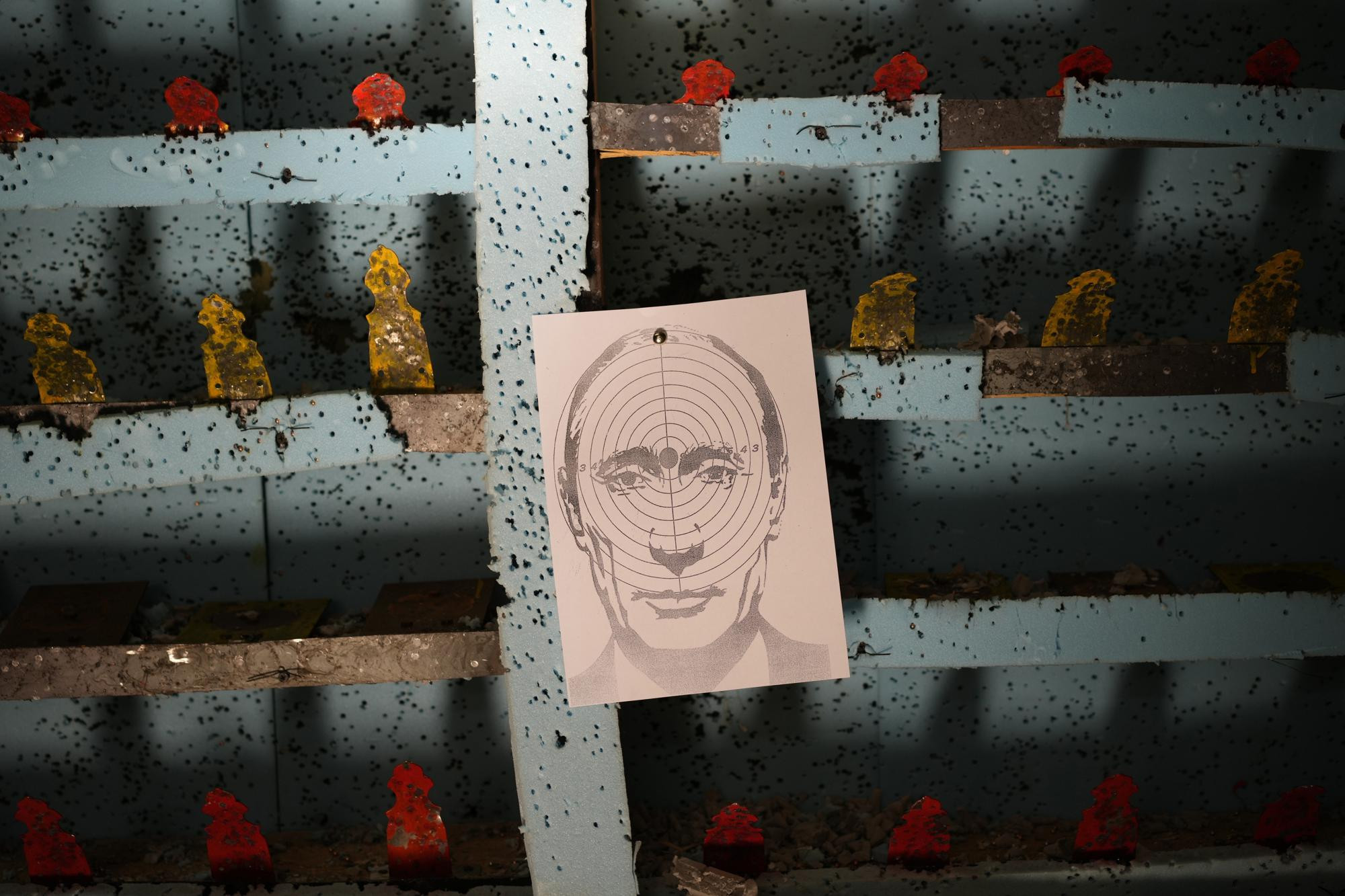 A picture of Russian President Vladimir Putin hangs at a target practice range in Lviv in western Ukraine, Thursday, March 17, 2022. (AP Photo/Bernat Armangue)
A picture of Russian President Vladimir Putin hangs at a target practice range in Lviv in western Ukraine, Thursday, March 17, 2022. (AP Photo/Bernat Armangue)
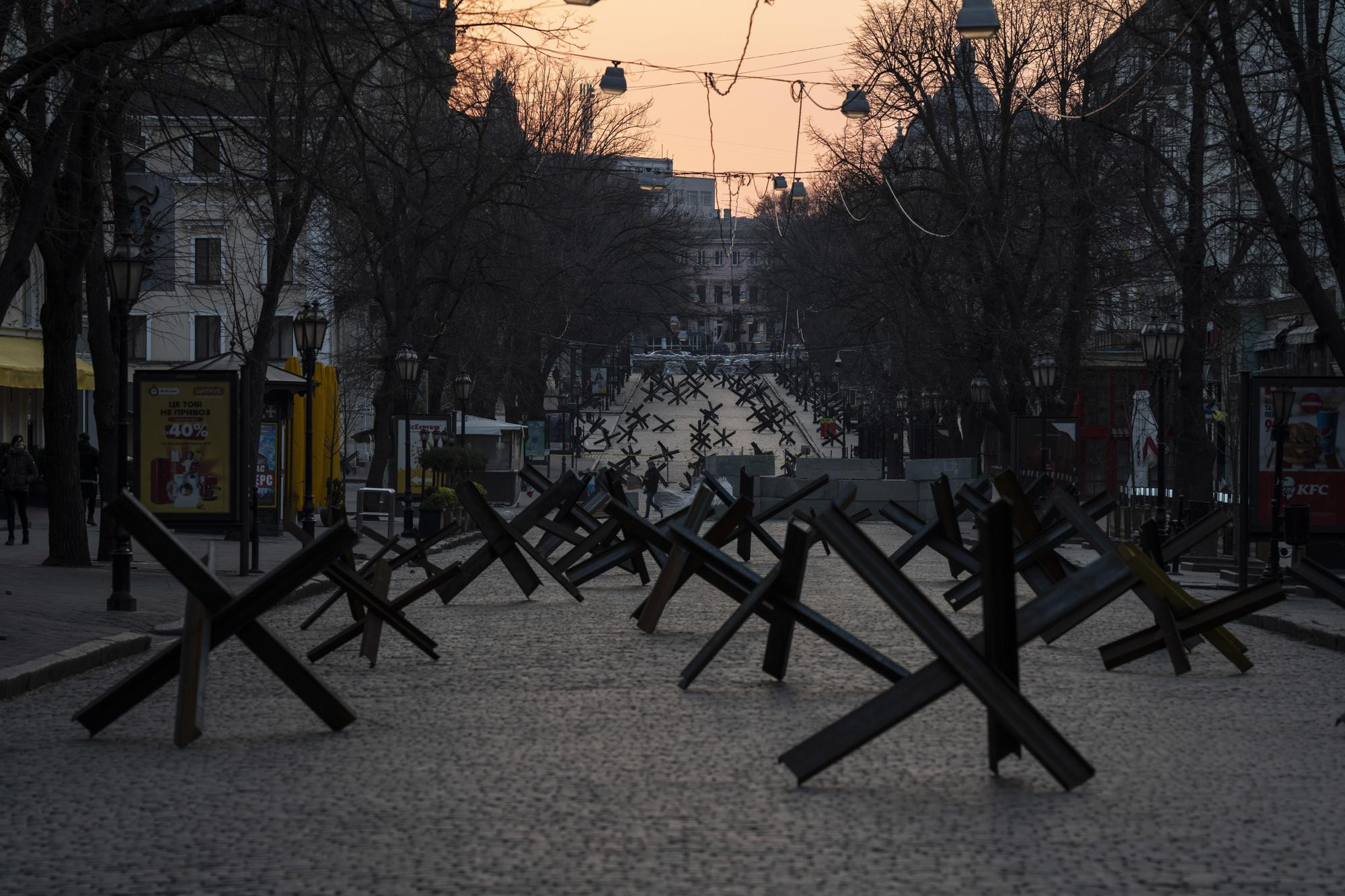 Anti-tank barricades block a street placed in preparation for a possible Russian offensive in Odesa, Ukraine, March 24, 2022. (AP Photo/Petros Giannakouris, File)
Anti-tank barricades block a street placed in preparation for a possible Russian offensive in Odesa, Ukraine, March 24, 2022. (AP Photo/Petros Giannakouris, File)
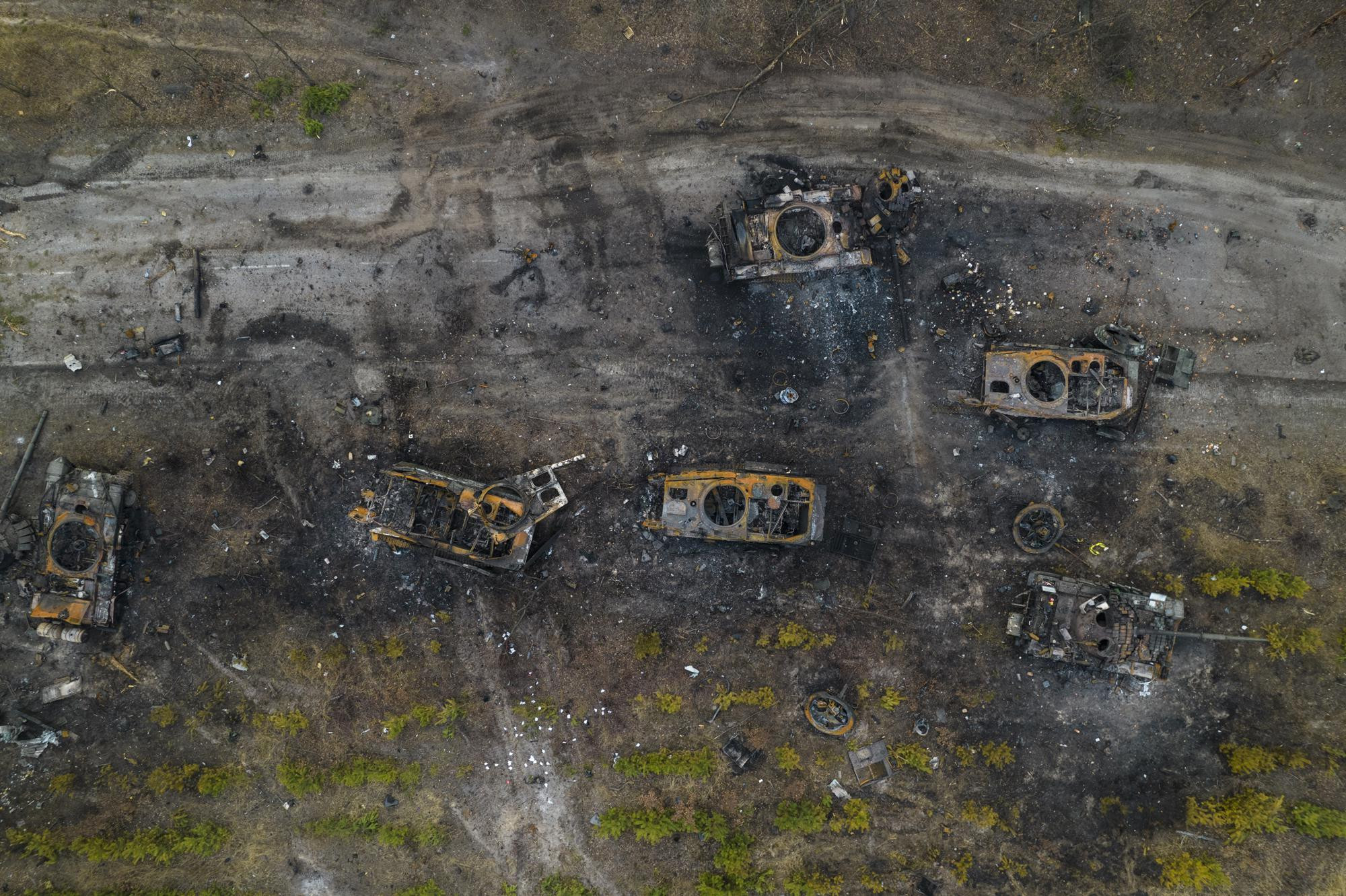 Destroyed Russian armored vehicles stand idle on the outskirts of Kyiv, Ukraine, Thursday, March 31, 2022. (AP Photo/Rodrigo Abd)
Destroyed Russian armored vehicles stand idle on the outskirts of Kyiv, Ukraine, Thursday, March 31, 2022. (AP Photo/Rodrigo Abd)
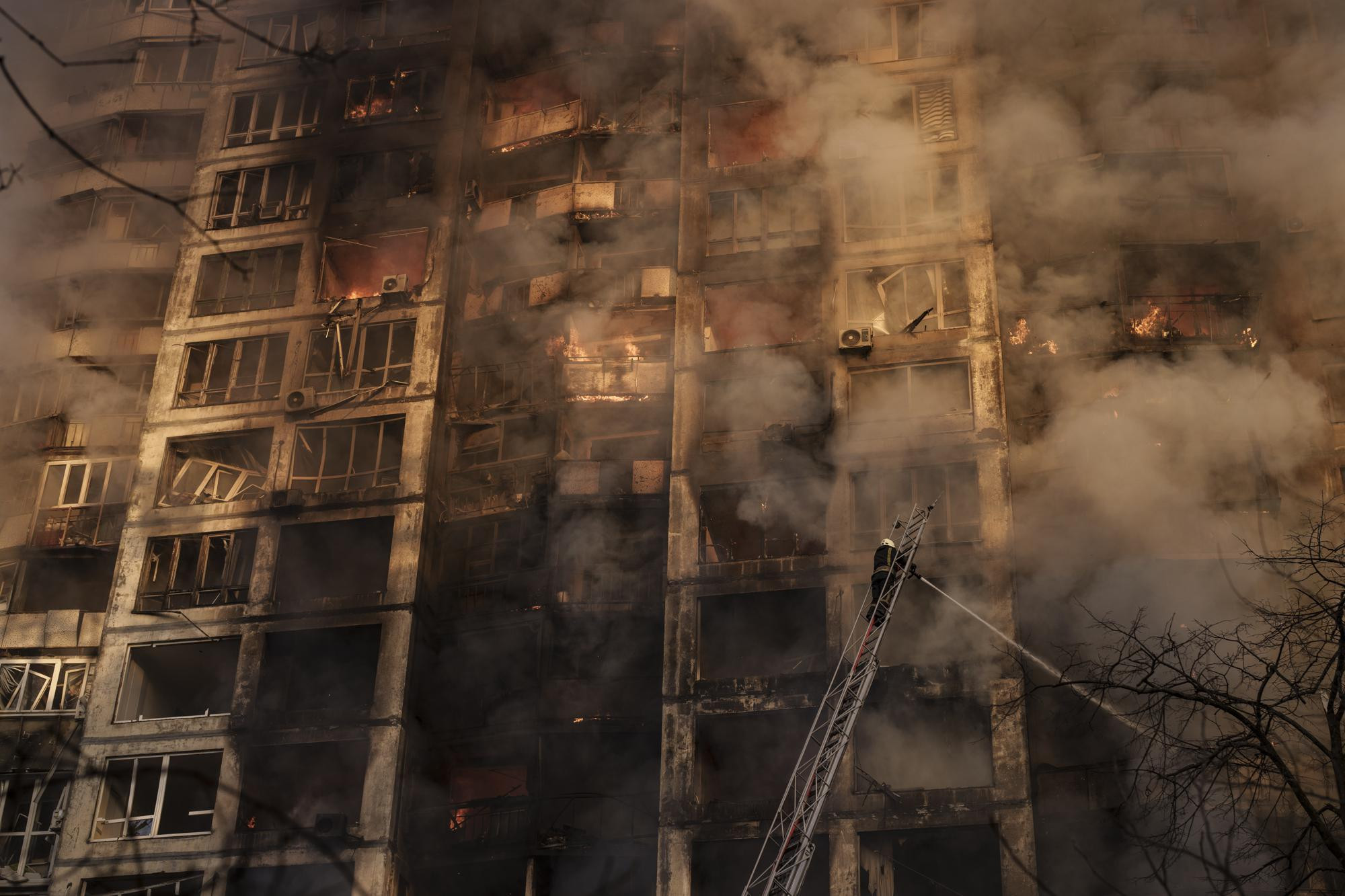 Ukrainian firefighters work at a bombed apartment building in Kyiv, Ukraine, Tuesday, March 15, 2022. (AP Photo/Felipe Dana)
Ukrainian firefighters work at a bombed apartment building in Kyiv, Ukraine, Tuesday, March 15, 2022. (AP Photo/Felipe Dana)
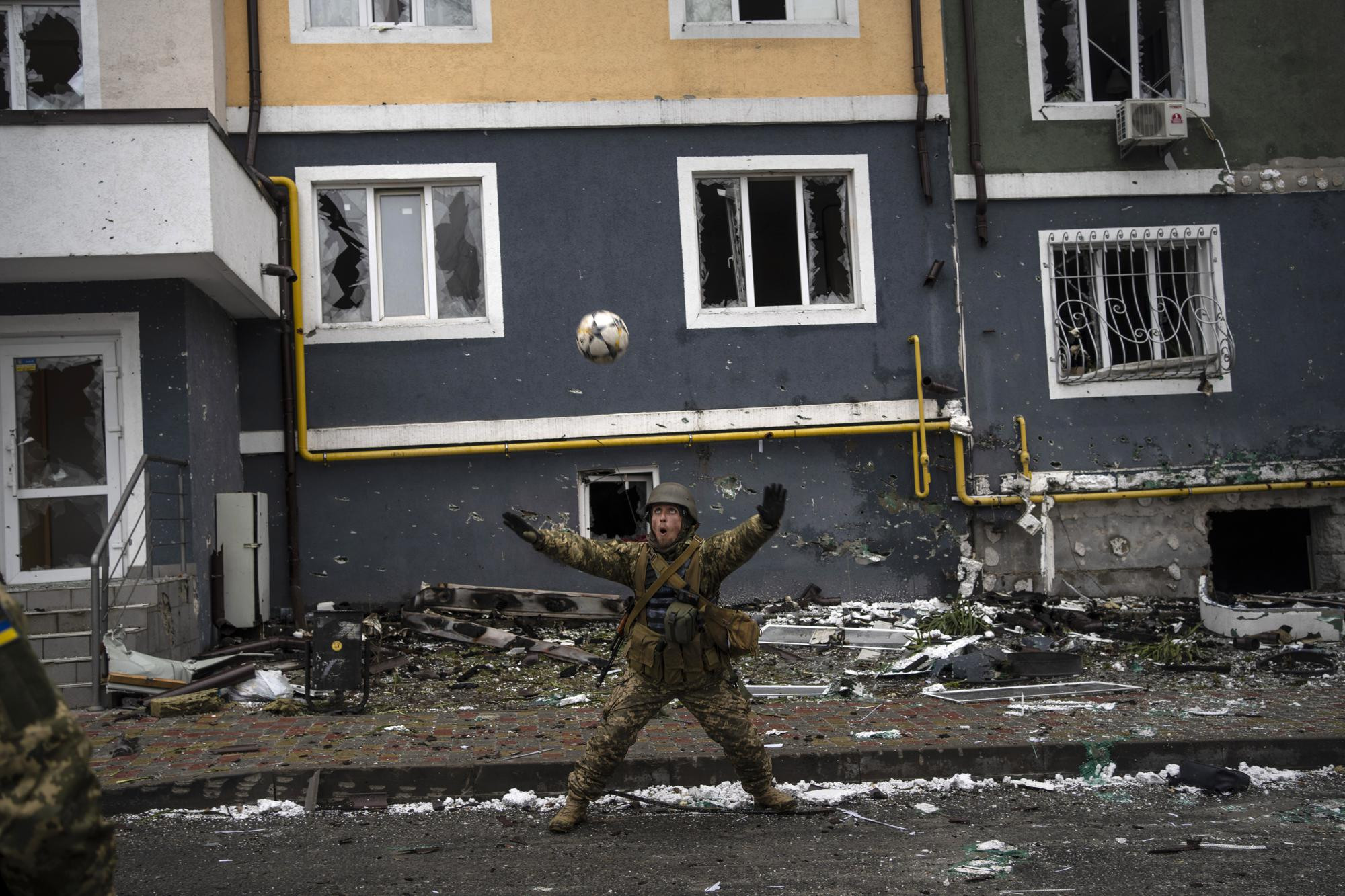 A Ukranian soldier plays a pick-up game in Irpin on the outskirts of Kyiv, Ukraine, Saturday, April 2, 2022. (AP Photo/Rodrigo Abd)
A Ukranian soldier plays a pick-up game in Irpin on the outskirts of Kyiv, Ukraine, Saturday, April 2, 2022. (AP Photo/Rodrigo Abd)
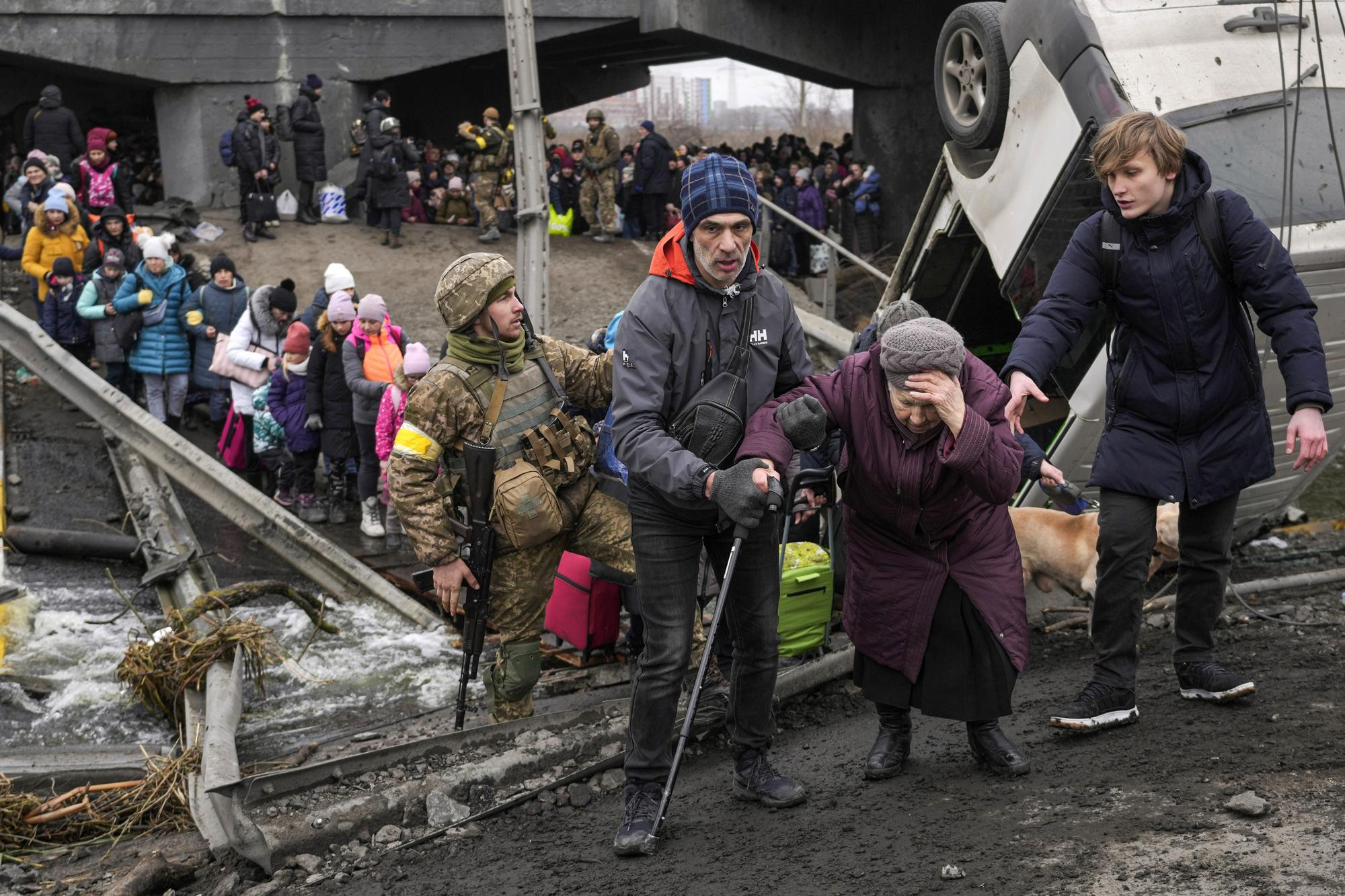 An elderly woman is assisted to cross the Irpin River on an improvised path under a bridge that was destroyed by Ukrainian troops to slow the Russian military advance while fleeing the town of Irpin, Ukraine, Saturday, March 5, 2022. (AP Photo/Vadim Ghirda, File)
An elderly woman is assisted to cross the Irpin River on an improvised path under a bridge that was destroyed by Ukrainian troops to slow the Russian military advance while fleeing the town of Irpin, Ukraine, Saturday, March 5, 2022. (AP Photo/Vadim Ghirda, File)
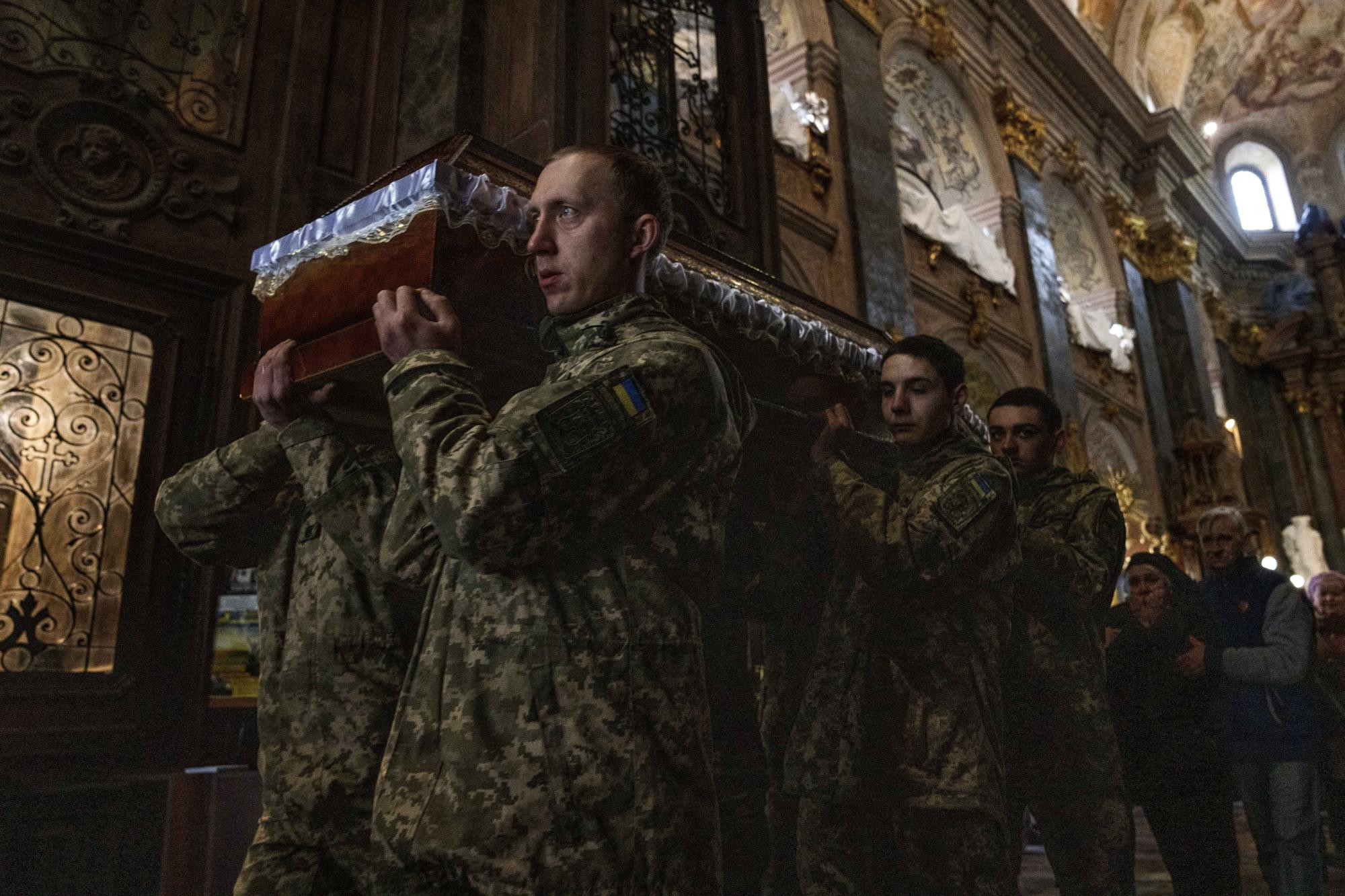 The mother of 40-year-old Senior Lieutenant Oliynyk Dmytro, who was killed in combat, mourns his death as she walks behind his coffin during his funeral outside the Holy Apostles Peter and Paul Church in Lviv, western Ukraine, Saturday, April 2, 2022. (AP Photo/Nariman El-Mofty)
The mother of 40-year-old Senior Lieutenant Oliynyk Dmytro, who was killed in combat, mourns his death as she walks behind his coffin during his funeral outside the Holy Apostles Peter and Paul Church in Lviv, western Ukraine, Saturday, April 2, 2022. (AP Photo/Nariman El-Mofty)
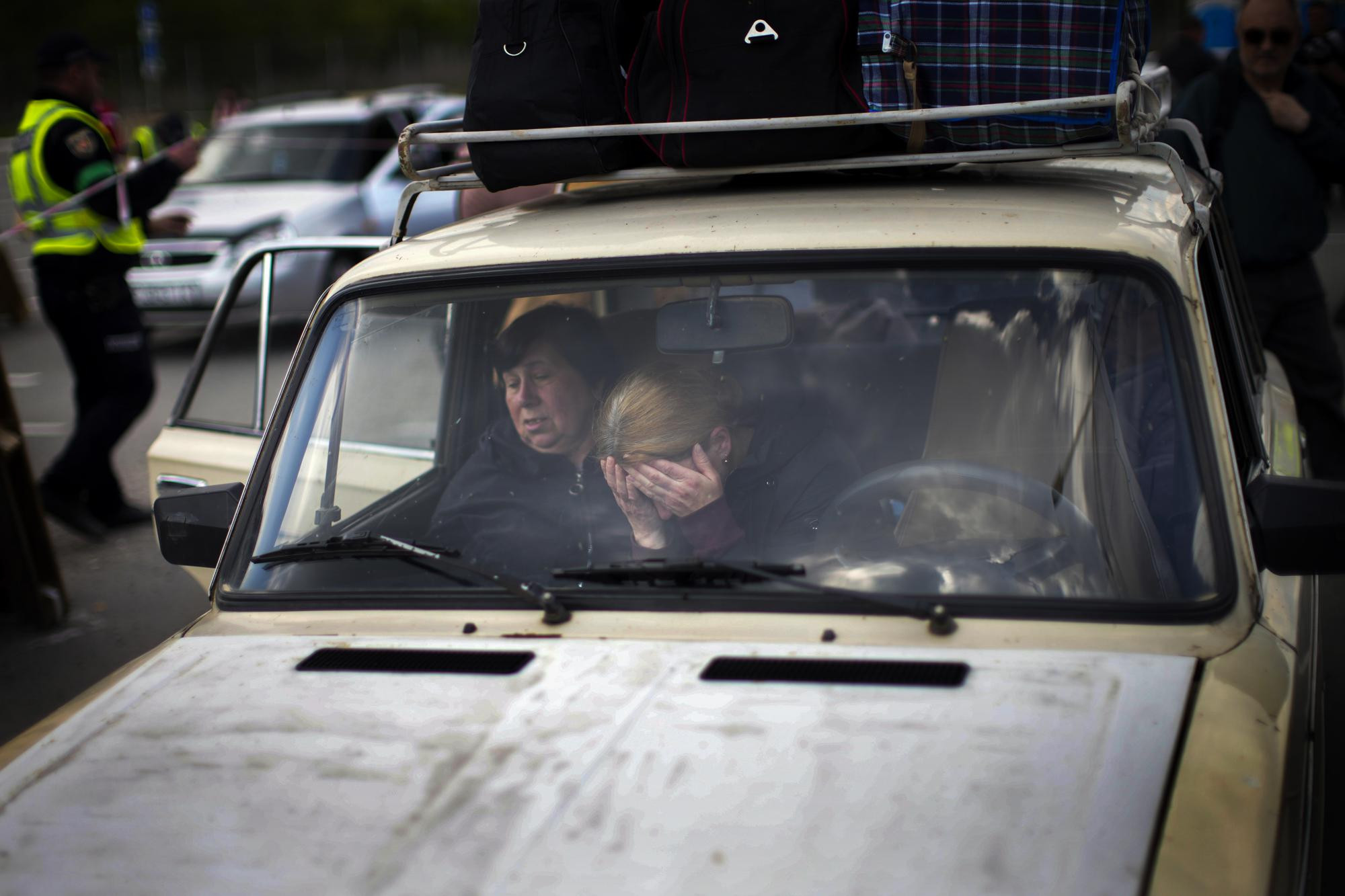 People wait in a car to be processed at a reception center for displaced people in Zaporizhzhia, Ukraine, Monday, May 2, 2022. (AP Photo/Francisco Seco)
People wait in a car to be processed at a reception center for displaced people in Zaporizhzhia, Ukraine, Monday, May 2, 2022. (AP Photo/Francisco Seco)
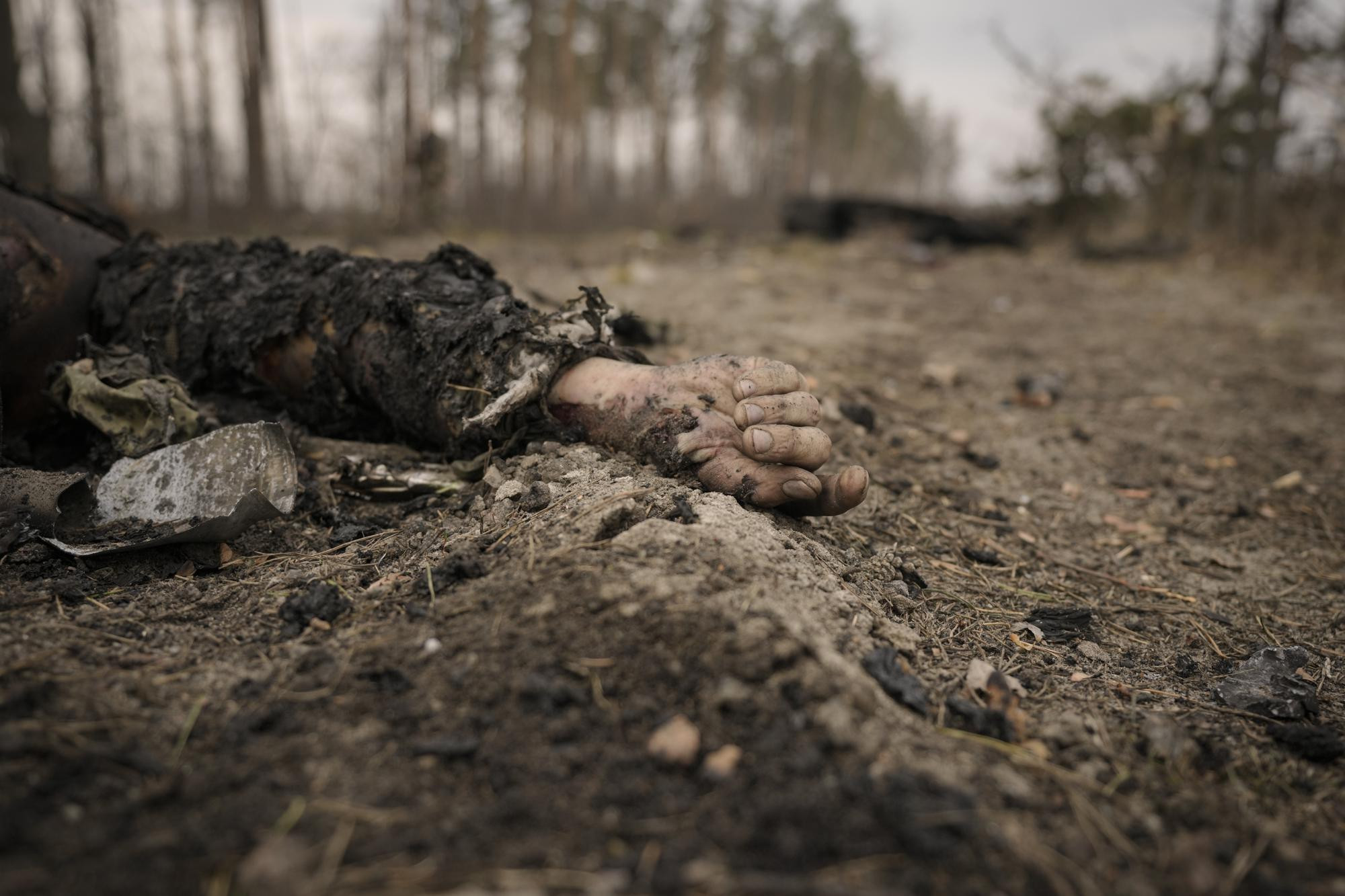 The bodies of Russian servicemen lie on the ground after an attack on their position by Ukrainian forces outside Kyiv, Ukraine, Thursday, March 31, 2022.(AP Photo/Vadim Ghirda)
The bodies of Russian servicemen lie on the ground after an attack on their position by Ukrainian forces outside Kyiv, Ukraine, Thursday, March 31, 2022.(AP Photo/Vadim Ghirda)
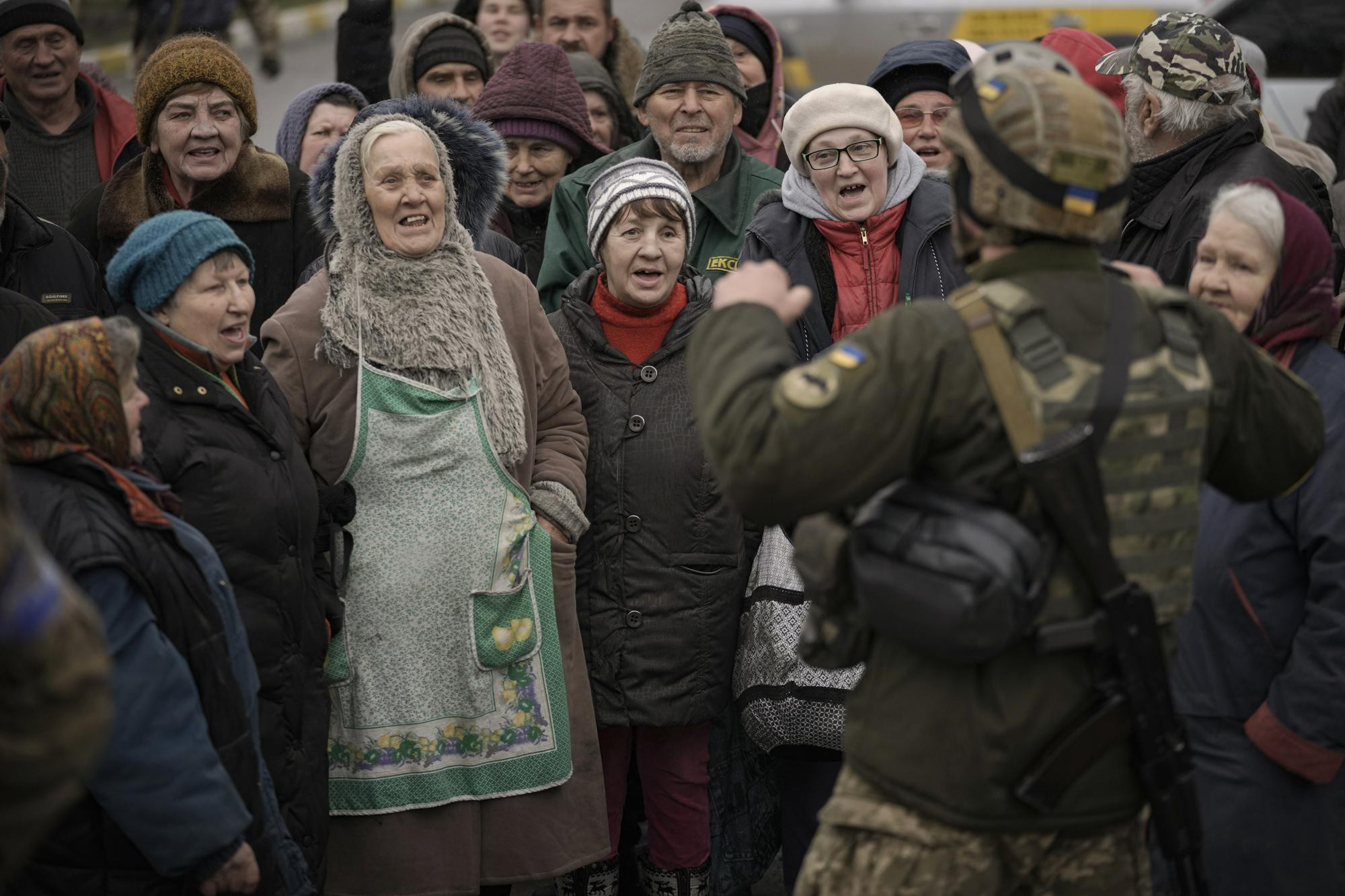 Civilians cheer along with a Ukrainian serviceman as a convoy of military and aid vehicles arrive at the formerly Russian-occupied Kyiv suburb of Bucha, Ukraine, Saturday, April 2, 2022.(AP Photo/Vadim Ghirda)
Civilians cheer along with a Ukrainian serviceman as a convoy of military and aid vehicles arrive at the formerly Russian-occupied Kyiv suburb of Bucha, Ukraine, Saturday, April 2, 2022.(AP Photo/Vadim Ghirda)
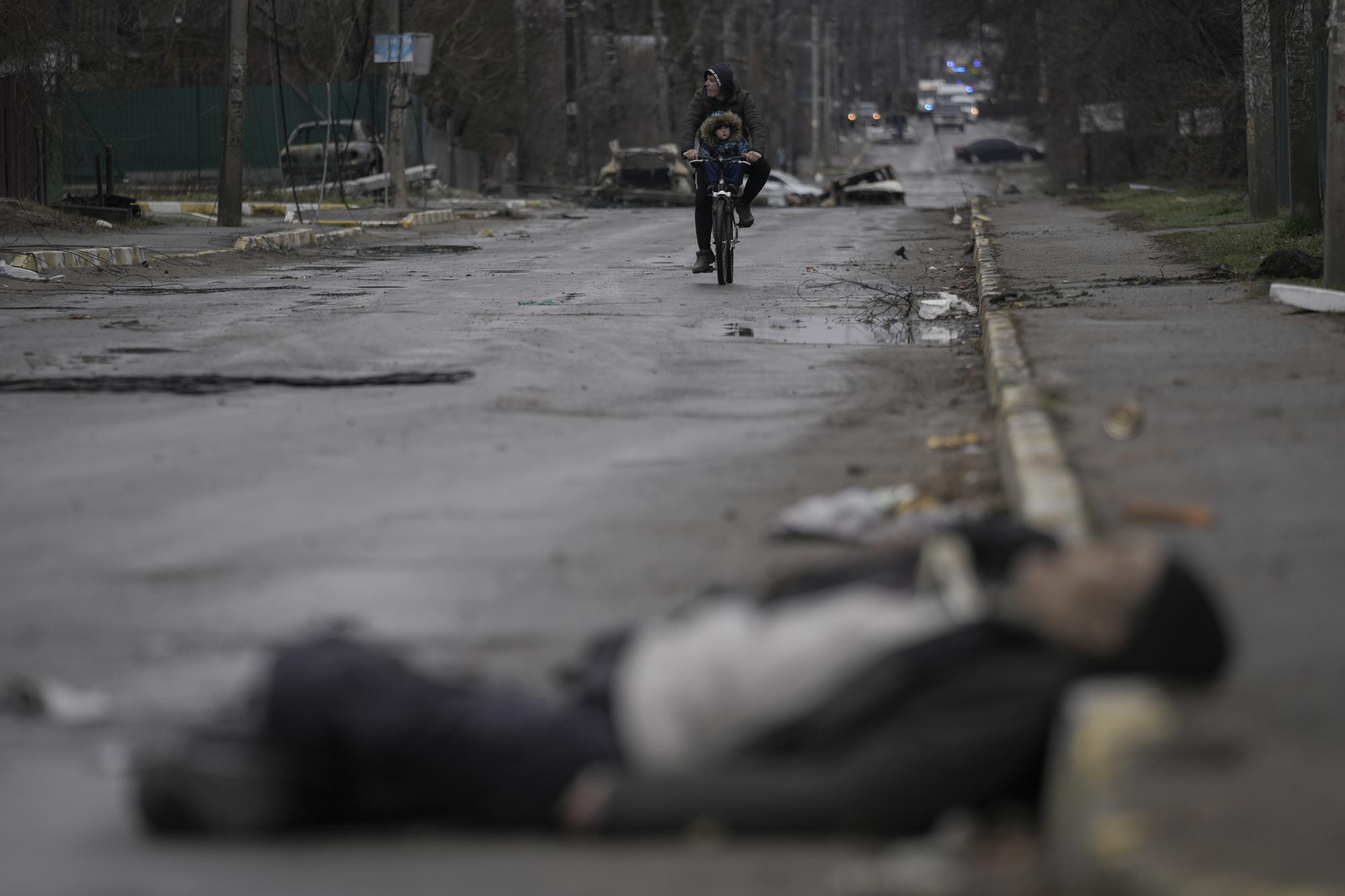 A man and child ride a bicycle through a street where civilian's bodies lie in the formerly Russian-occupied Kyiv suburb of Bucha, Ukraine, Saturday, April 2, 2022. (AP Photo/Vadim Ghirda)
A man and child ride a bicycle through a street where civilian's bodies lie in the formerly Russian-occupied Kyiv suburb of Bucha, Ukraine, Saturday, April 2, 2022. (AP Photo/Vadim Ghirda)
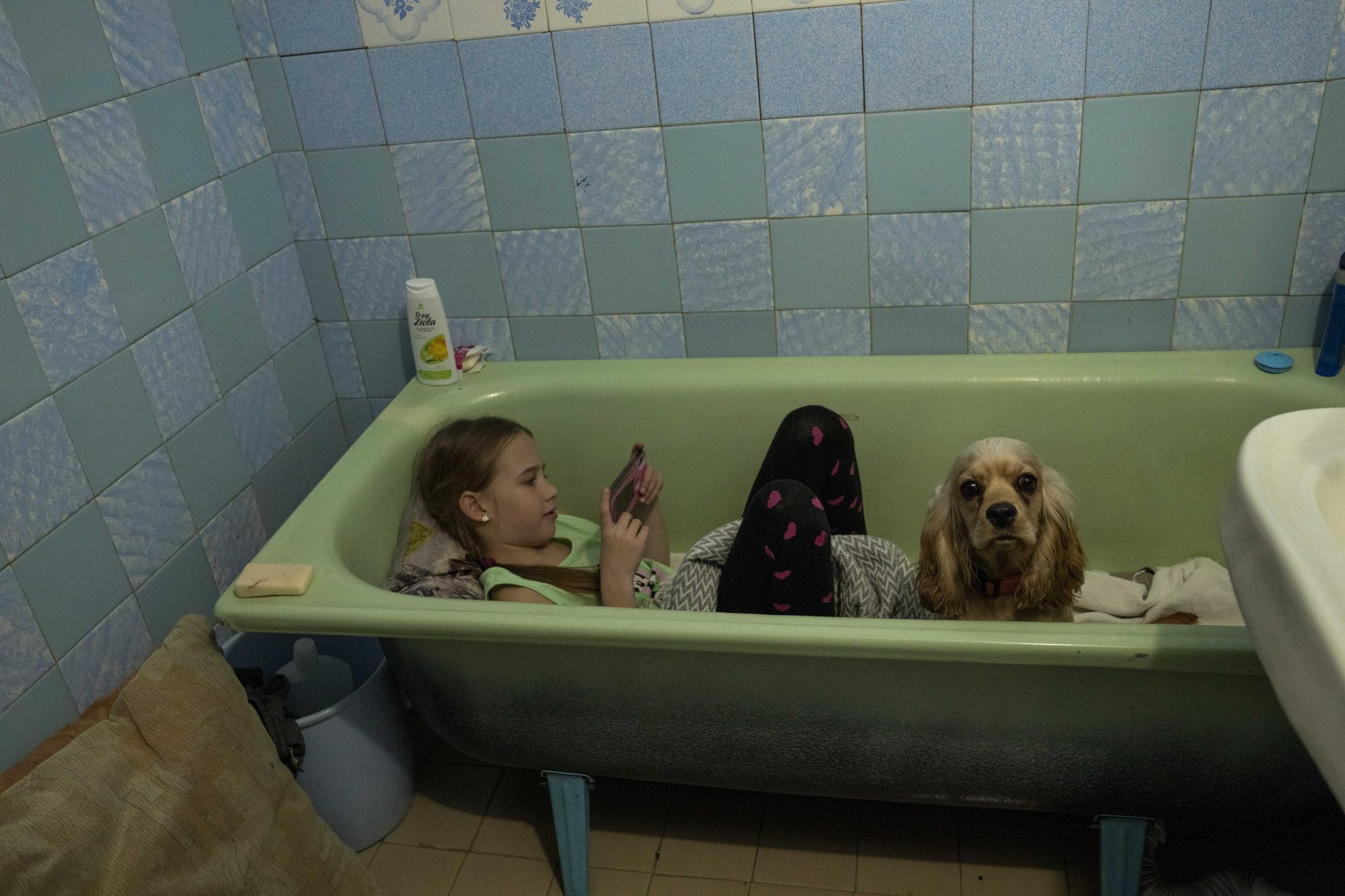 Zlata-Maria Shlapak sits with her puppy Letti in the bathtub while an air siren goes off, at the apartment her family is renting in Lviv where they took refuge in western Ukraine, Saturday, April 2, 2022. (AP Photo/Nariman El-Mofty)
Zlata-Maria Shlapak sits with her puppy Letti in the bathtub while an air siren goes off, at the apartment her family is renting in Lviv where they took refuge in western Ukraine, Saturday, April 2, 2022. (AP Photo/Nariman El-Mofty)
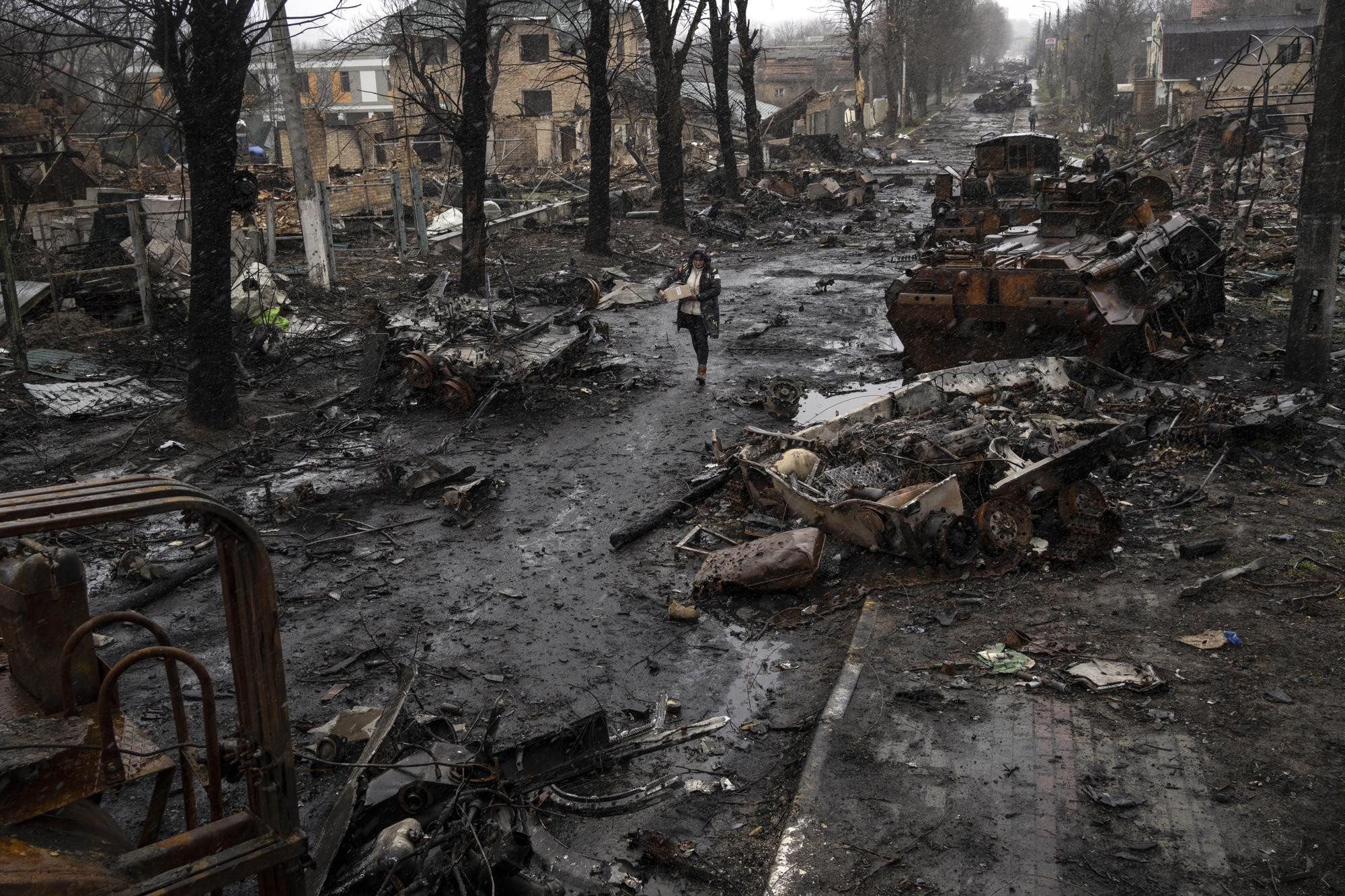 A woman navigates a debris-filled street where destroyed Russian military vehicles stand in Bucha on the outskirts of Kyiv, Ukraine, Sunday, April 3, 2022. (AP Photo/Rodrigo Abd)
A woman navigates a debris-filled street where destroyed Russian military vehicles stand in Bucha on the outskirts of Kyiv, Ukraine, Sunday, April 3, 2022. (AP Photo/Rodrigo Abd)
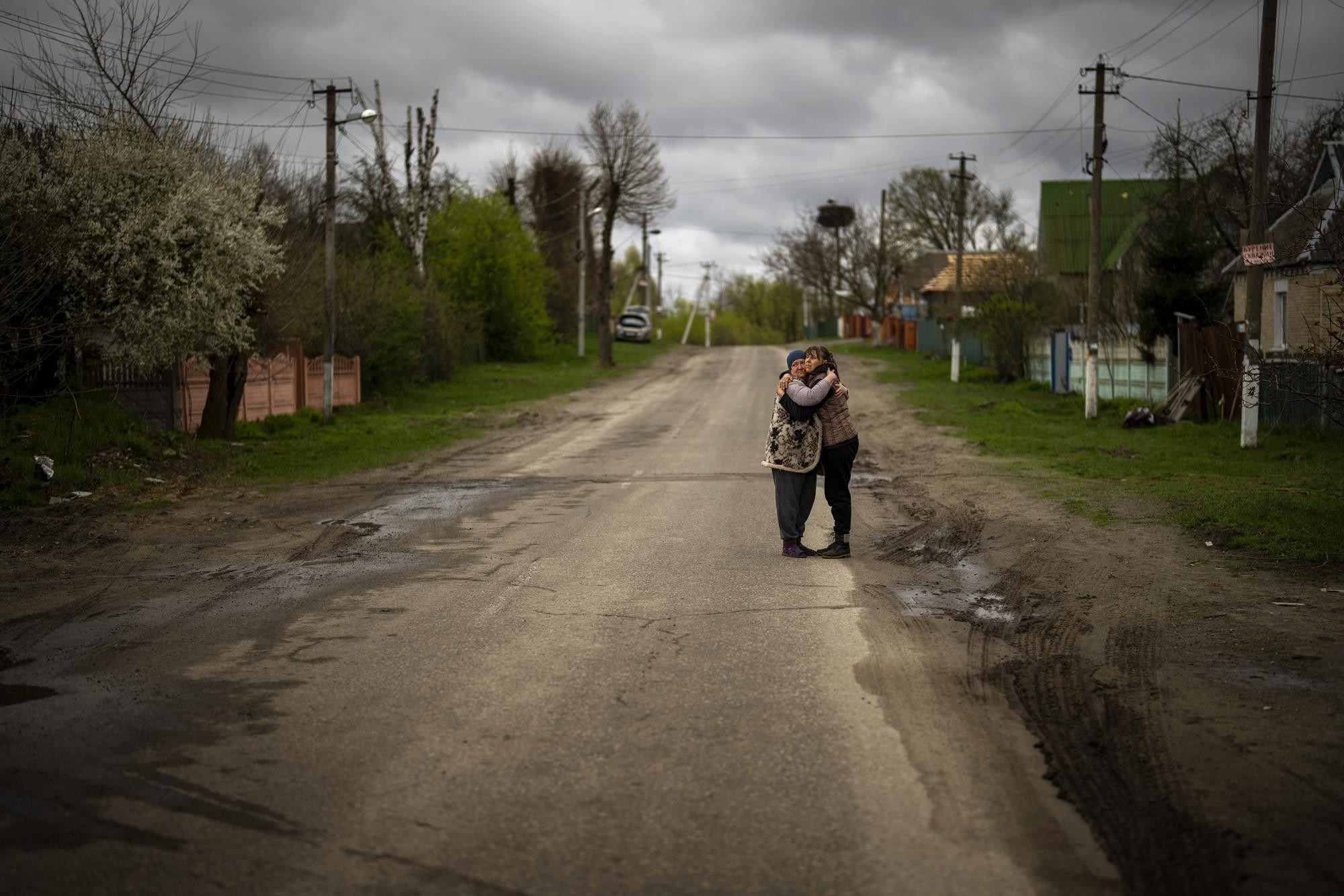 Tetyana Boikiv, right, hugs her neighbor Svitlana Pryimachenko after a funeral service for Boikiv’s husband, Mykola Moroz, in the Ozera village near Bucha, Ukraine, Tuesday, April 26, 2022. Mykola was taken by the Russian army from his house in Ozera on March 13, held for several weeks to an unknown location and found killed with gunshots about 15 km from his house home. (AP Photo/Emilio Morenatti)
Tetyana Boikiv, right, hugs her neighbor Svitlana Pryimachenko after a funeral service for Boikiv’s husband, Mykola Moroz, in the Ozera village near Bucha, Ukraine, Tuesday, April 26, 2022. Mykola was taken by the Russian army from his house in Ozera on March 13, held for several weeks to an unknown location and found killed with gunshots about 15 km from his house home. (AP Photo/Emilio Morenatti)
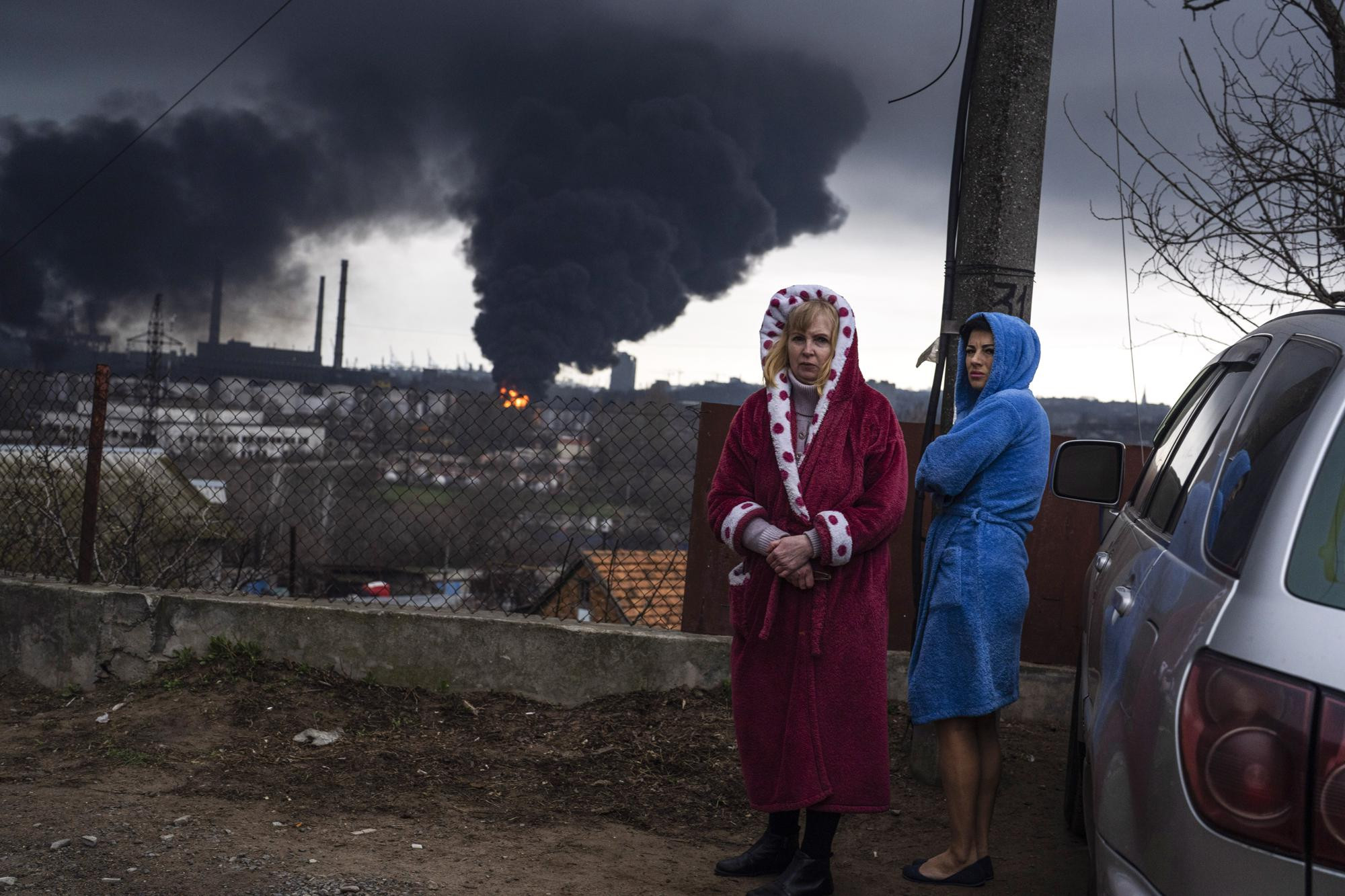 Women stand in their robes as smoke rises in the background after shelling in Odesa, Ukraine, Sunday, April 3, 2022. (AP Photo/Petros Giannakouris)
Women stand in their robes as smoke rises in the background after shelling in Odesa, Ukraine, Sunday, April 3, 2022. (AP Photo/Petros Giannakouris)
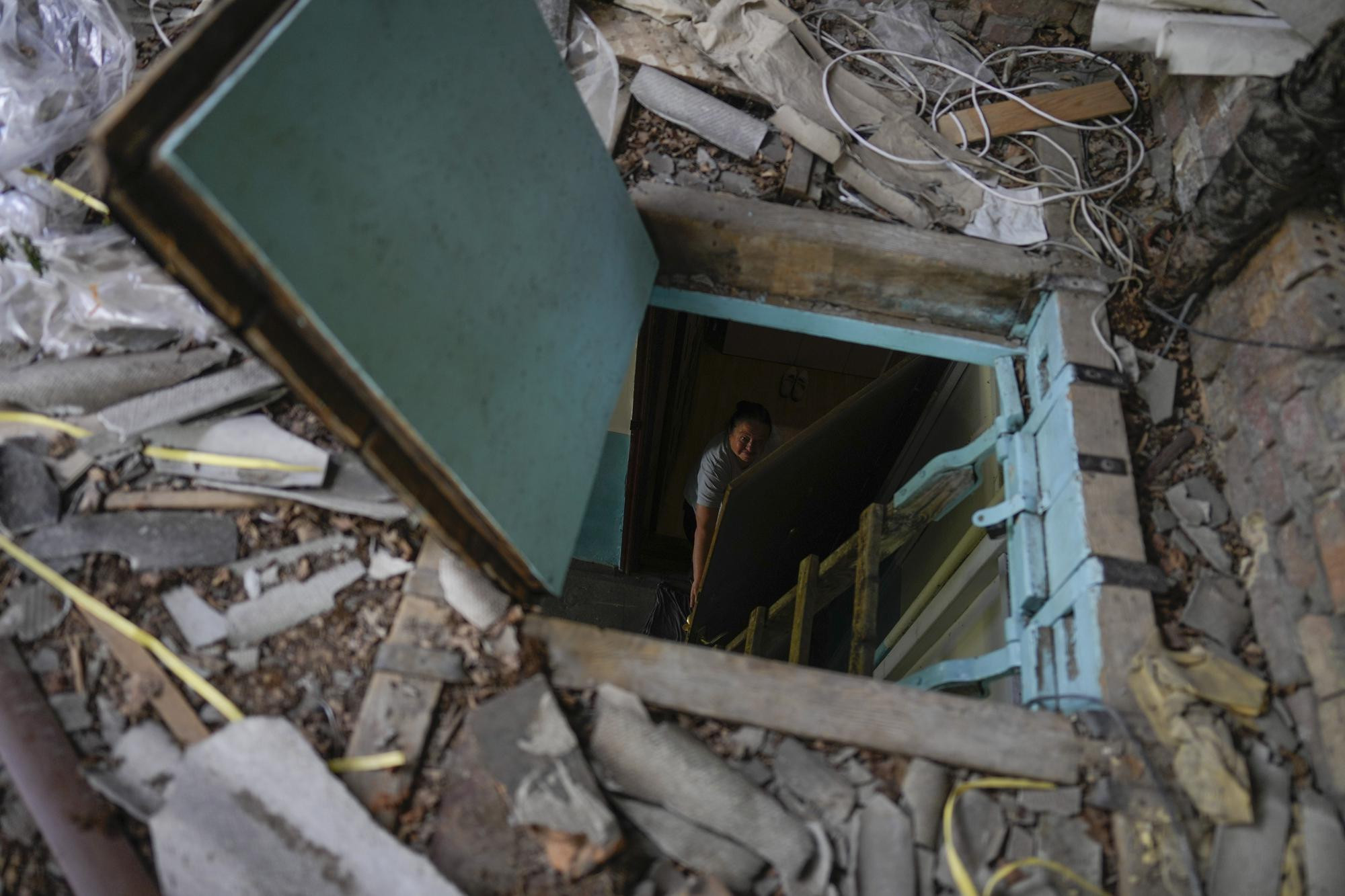 Liudmyla Voronina opens the skylight window of her roof as she stands inside her home that was damaged by attacks in Irpin on the outskirts of Kyiv, Ukraine, Thursday, May 26, 2022. (AP Photo/Natacha Pisarenko)
Liudmyla Voronina opens the skylight window of her roof as she stands inside her home that was damaged by attacks in Irpin on the outskirts of Kyiv, Ukraine, Thursday, May 26, 2022. (AP Photo/Natacha Pisarenko)
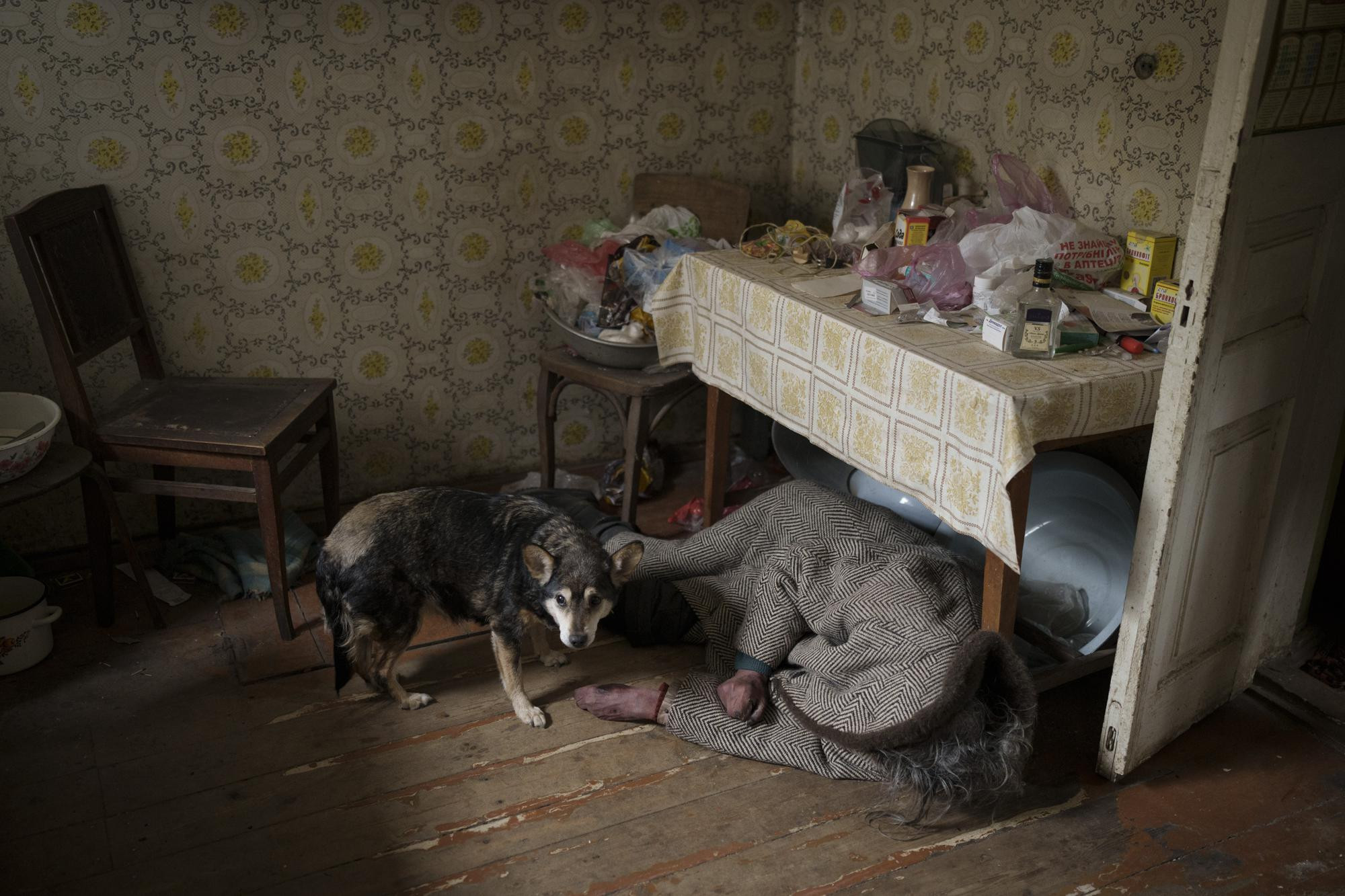 A dog stands next to the body of an elderly woman killed inside a home in Bucha on the outskirts of Kyiv, Ukraine, Tuesday, April 5, 2022. (AP Photo/Felipe Dana)
A dog stands next to the body of an elderly woman killed inside a home in Bucha on the outskirts of Kyiv, Ukraine, Tuesday, April 5, 2022. (AP Photo/Felipe Dana)
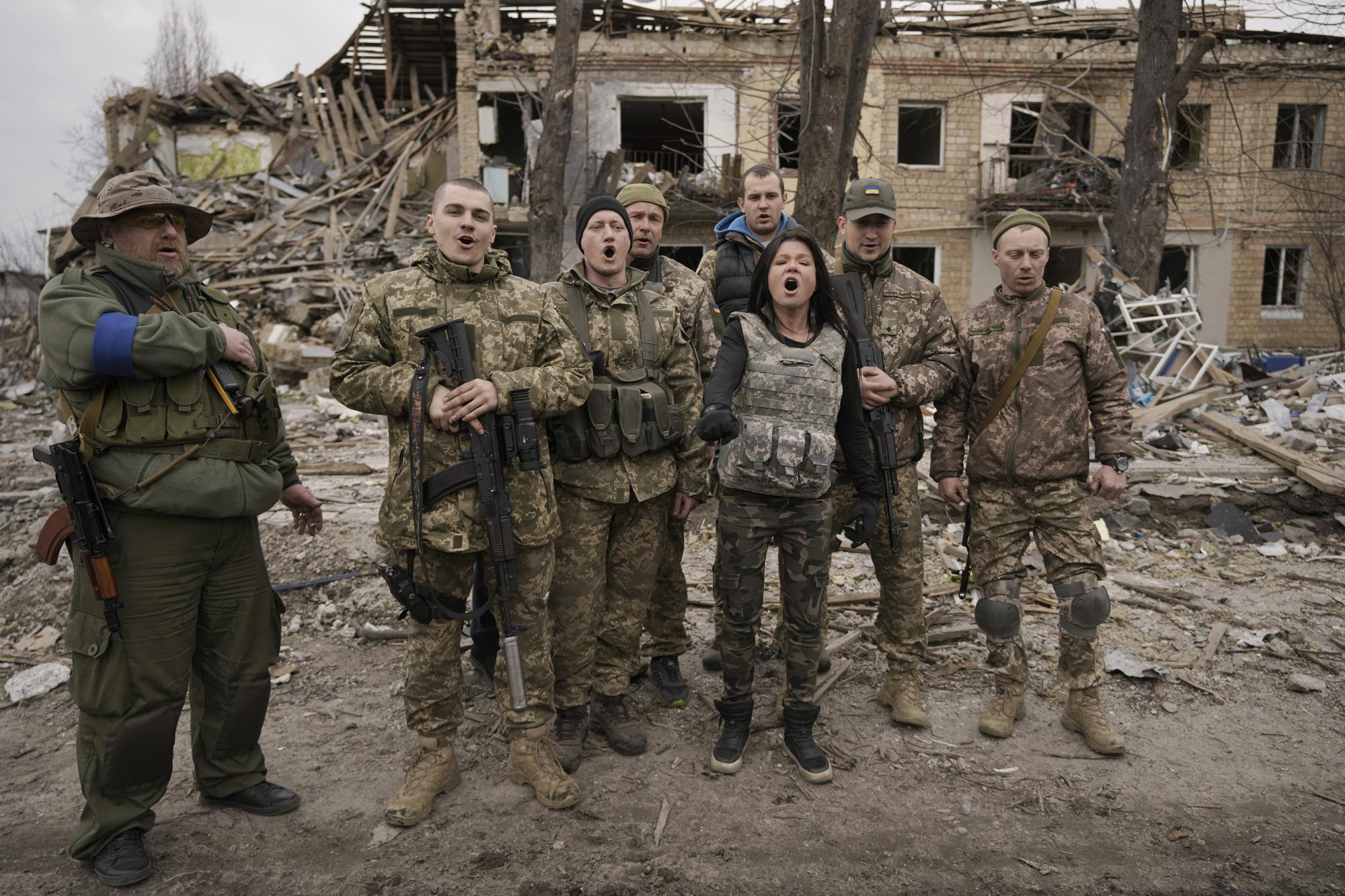 Ukrainian servicemen sing a patriotic song amid buildings destroyed during fighting between Ukrainian and Russian forces in Borodyanka, Ukraine, Tuesday, April 5, 2022.(AP Photo/Vadim Ghirda)
Ukrainian servicemen sing a patriotic song amid buildings destroyed during fighting between Ukrainian and Russian forces in Borodyanka, Ukraine, Tuesday, April 5, 2022.(AP Photo/Vadim Ghirda)
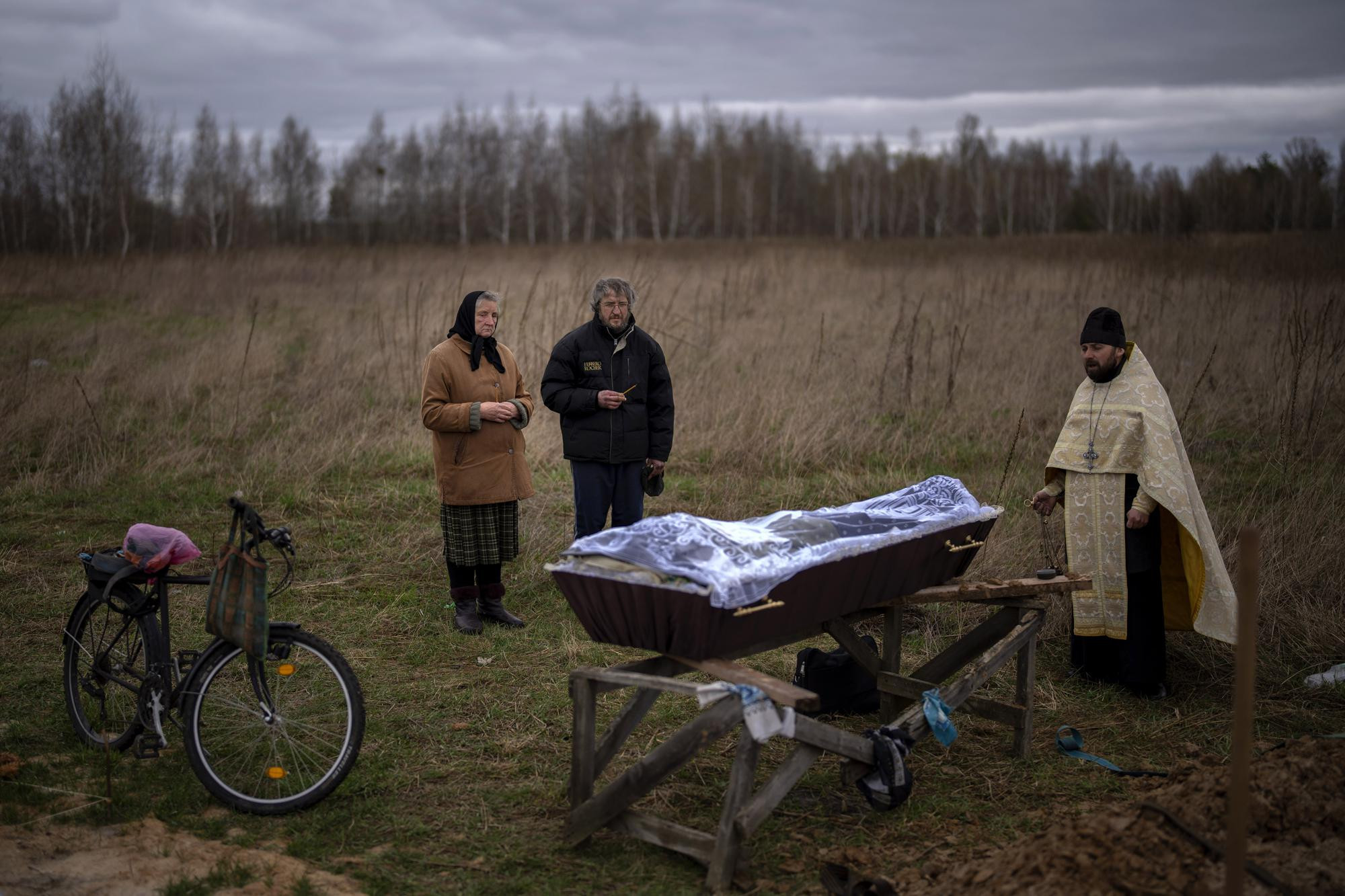 Nadiya Trubchaninova and her son Oleg Trubchaninov attend the funeral of her other son Vadym, who was killed by a Russian army gunshot on March 30, in Bucha on the outskirts of Kyiv, Ukraine, Saturday, April 16, 2022. (AP Photo/Emilio Morenatti)
Nadiya Trubchaninova and her son Oleg Trubchaninov attend the funeral of her other son Vadym, who was killed by a Russian army gunshot on March 30, in Bucha on the outskirts of Kyiv, Ukraine, Saturday, April 16, 2022. (AP Photo/Emilio Morenatti)
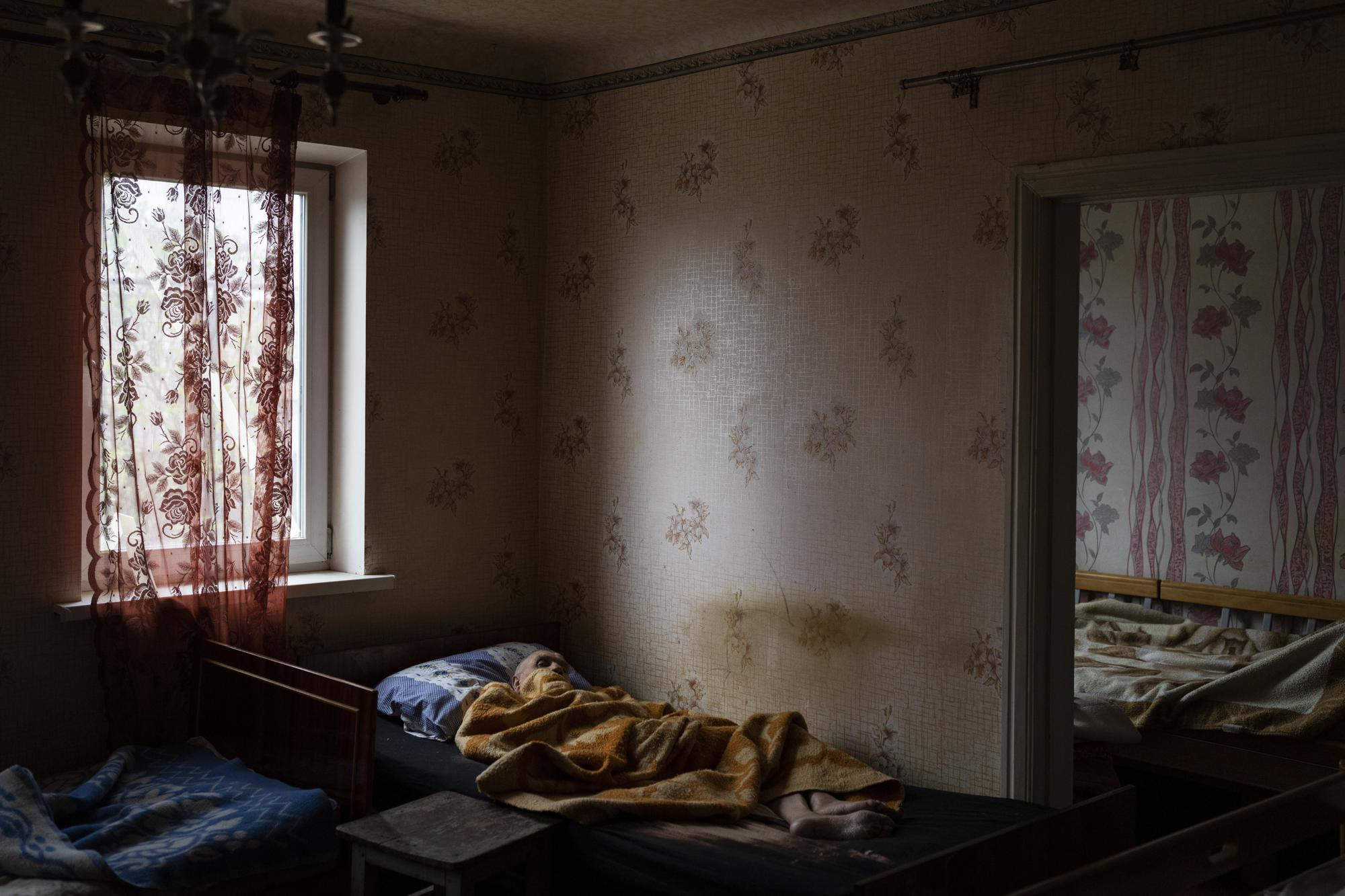 An elderly man lies at a hospice center in Chasiv Yar in the Donetsk district of Ukraine, Monday, April 18, 2022. At least 35 men and women were helped by volunteers to flee the region that has been under attack and taken to Khmelnytskyi in western Ukraine. (AP Photo/Petros Giannakouris)
An elderly man lies at a hospice center in Chasiv Yar in the Donetsk district of Ukraine, Monday, April 18, 2022. At least 35 men and women were helped by volunteers to flee the region that has been under attack and taken to Khmelnytskyi in western Ukraine. (AP Photo/Petros Giannakouris)
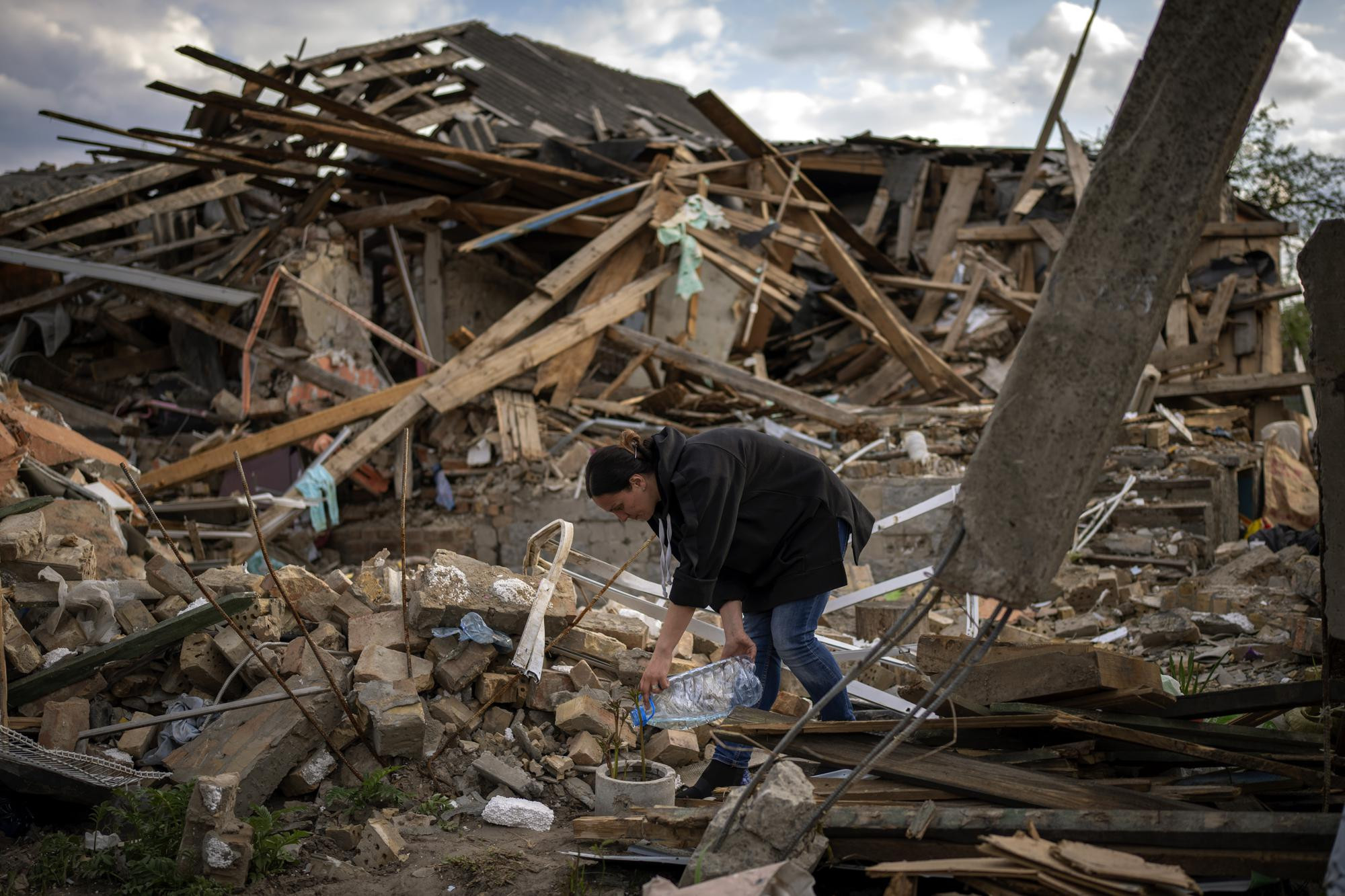 Anna Shevchenko waters the few flowers that survived bombing in her garden in Irpin, near Kyiv, Ukraine, Tuesday, May 3, 2022. The house, built by Shevchenko's grandparents, was nearly completely destroyed by bombing in late March. "It is new life. So I tried to save my flowers," she said. (AP Photo/Emilio Morenatti)
Anna Shevchenko waters the few flowers that survived bombing in her garden in Irpin, near Kyiv, Ukraine, Tuesday, May 3, 2022. The house, built by Shevchenko's grandparents, was nearly completely destroyed by bombing in late March. "It is new life. So I tried to save my flowers," she said. (AP Photo/Emilio Morenatti)
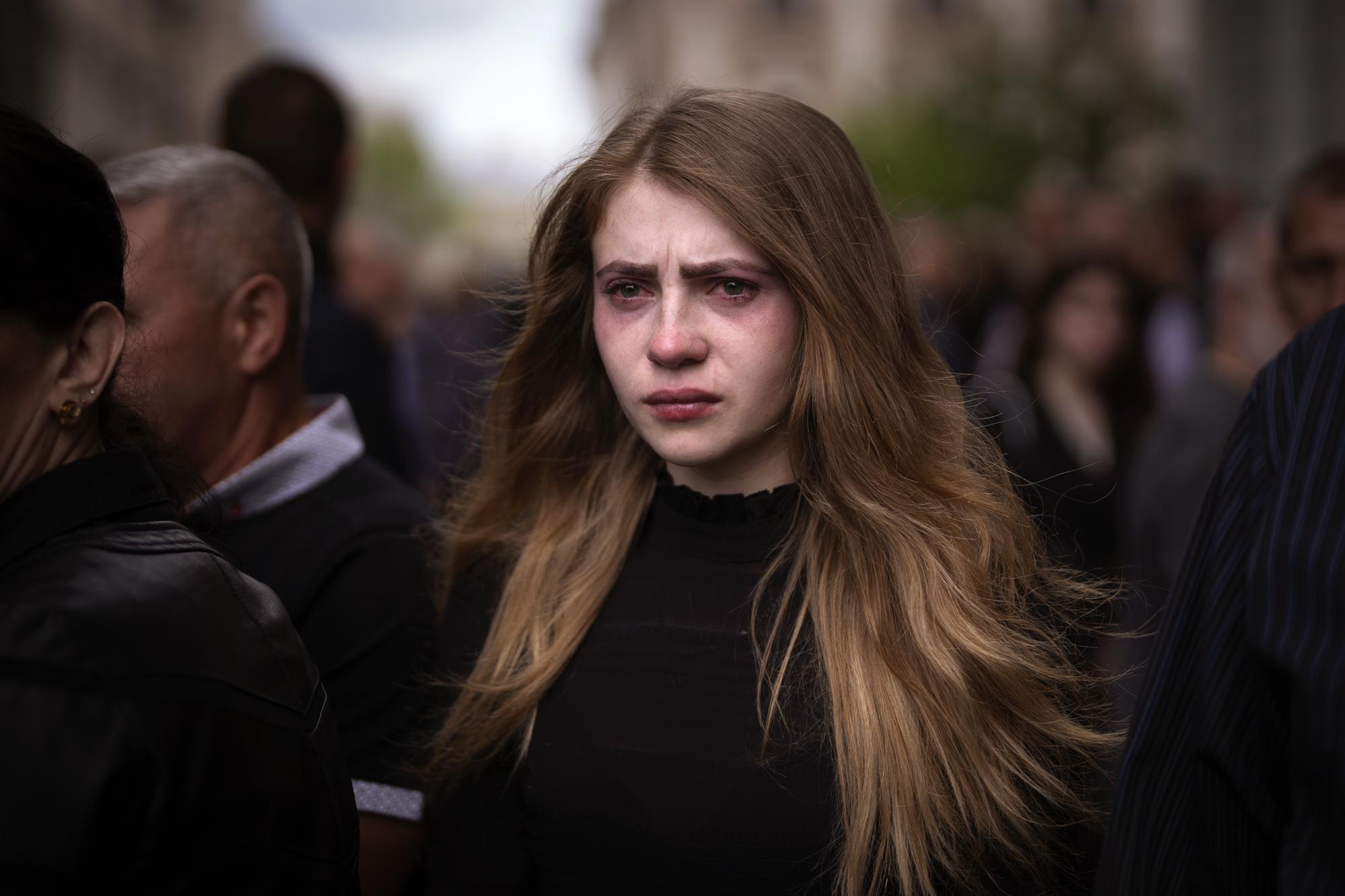 A woman cries during the funerals of three Ukrainian military servicemen, Melnyk Andriy, Shufryn Andriy and Ankratov Oleksandra, who were killed in the east of the country, in Lviv, Ukraine, Saturday, May 14, 2022. (AP Photo/Emilio Morenatti)
A woman cries during the funerals of three Ukrainian military servicemen, Melnyk Andriy, Shufryn Andriy and Ankratov Oleksandra, who were killed in the east of the country, in Lviv, Ukraine, Saturday, May 14, 2022. (AP Photo/Emilio Morenatti)
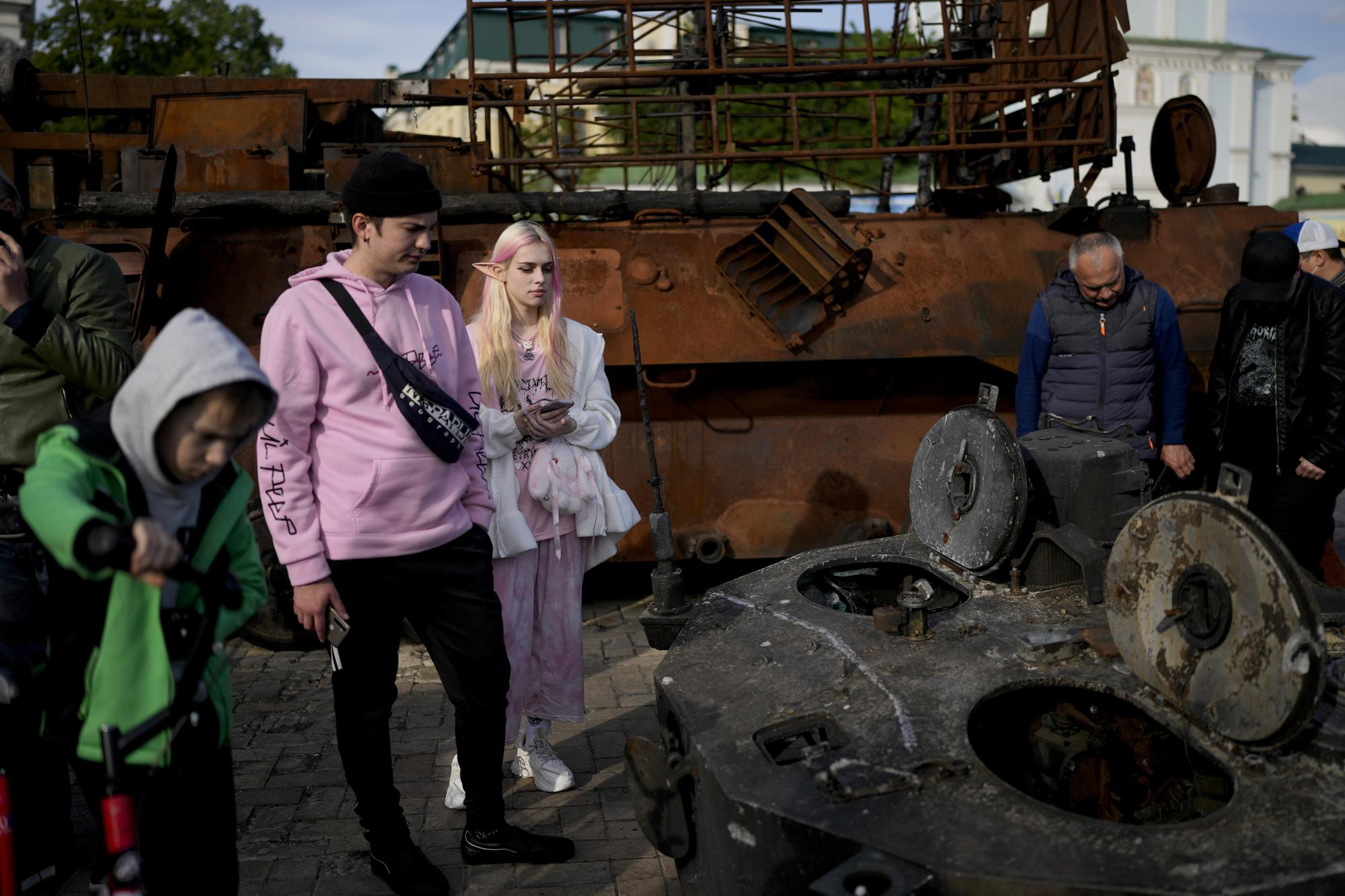 People look at a destroyed Russian tank placed at Mykhailivs'ka Square in downtown Kyiv, Ukraine, Monday, May 23, 2022. (AP Photo/Natacha Pisarenko)
People look at a destroyed Russian tank placed at Mykhailivs'ka Square in downtown Kyiv, Ukraine, Monday, May 23, 2022. (AP Photo/Natacha Pisarenko)
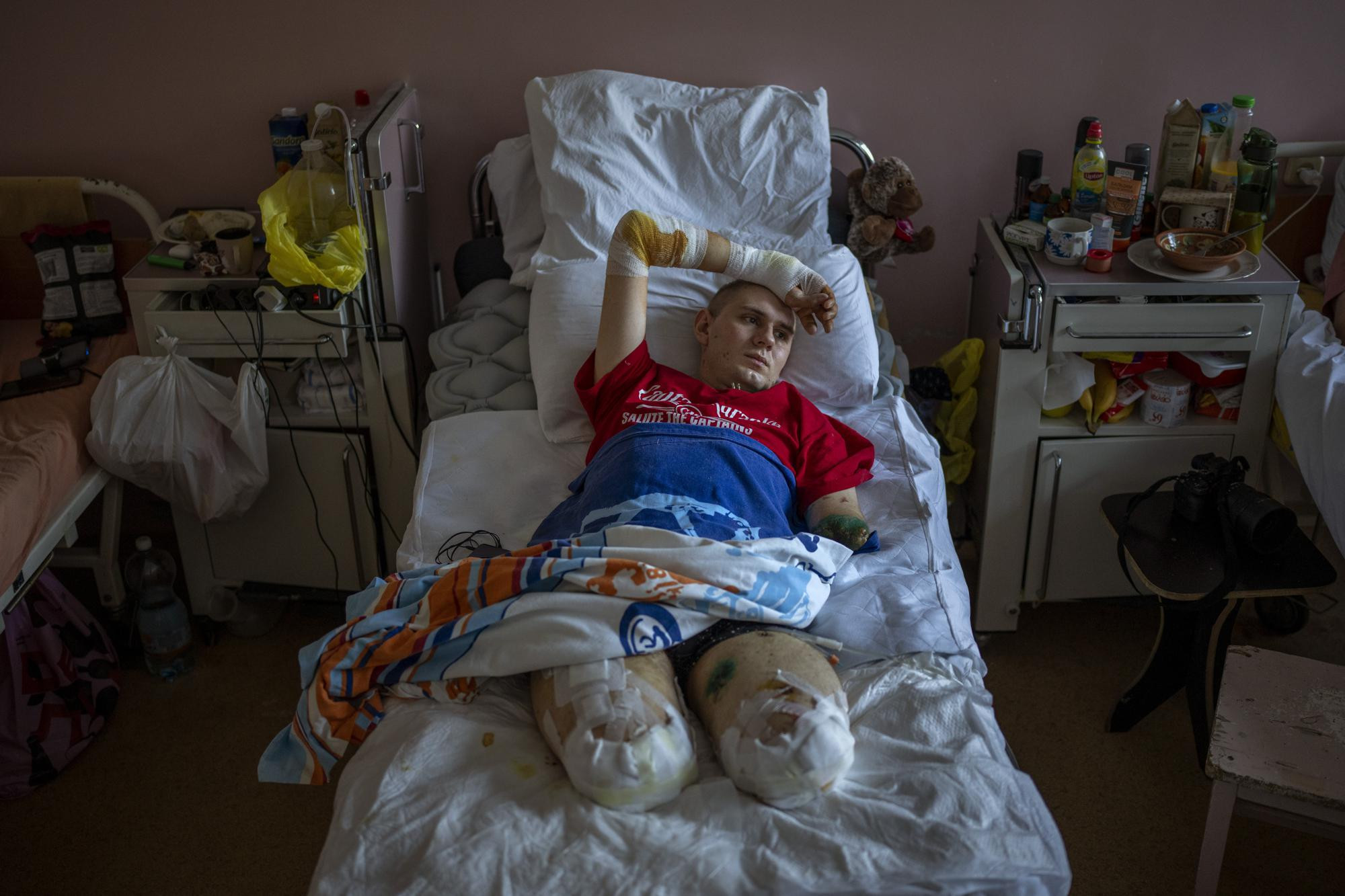 Anton Gladun lies on his bed at the Third City Hospital in Cherkasy, Ukraine, Thursday, May 5, 2022. Anton, a 22-year-old military medic deployed on the front lines in eastern Ukraine, lost both legs and left arm in a mine explosion on March 27. (AP Photo/Emilio Morenatti)
Anton Gladun lies on his bed at the Third City Hospital in Cherkasy, Ukraine, Thursday, May 5, 2022. Anton, a 22-year-old military medic deployed on the front lines in eastern Ukraine, lost both legs and left arm in a mine explosion on March 27. (AP Photo/Emilio Morenatti)
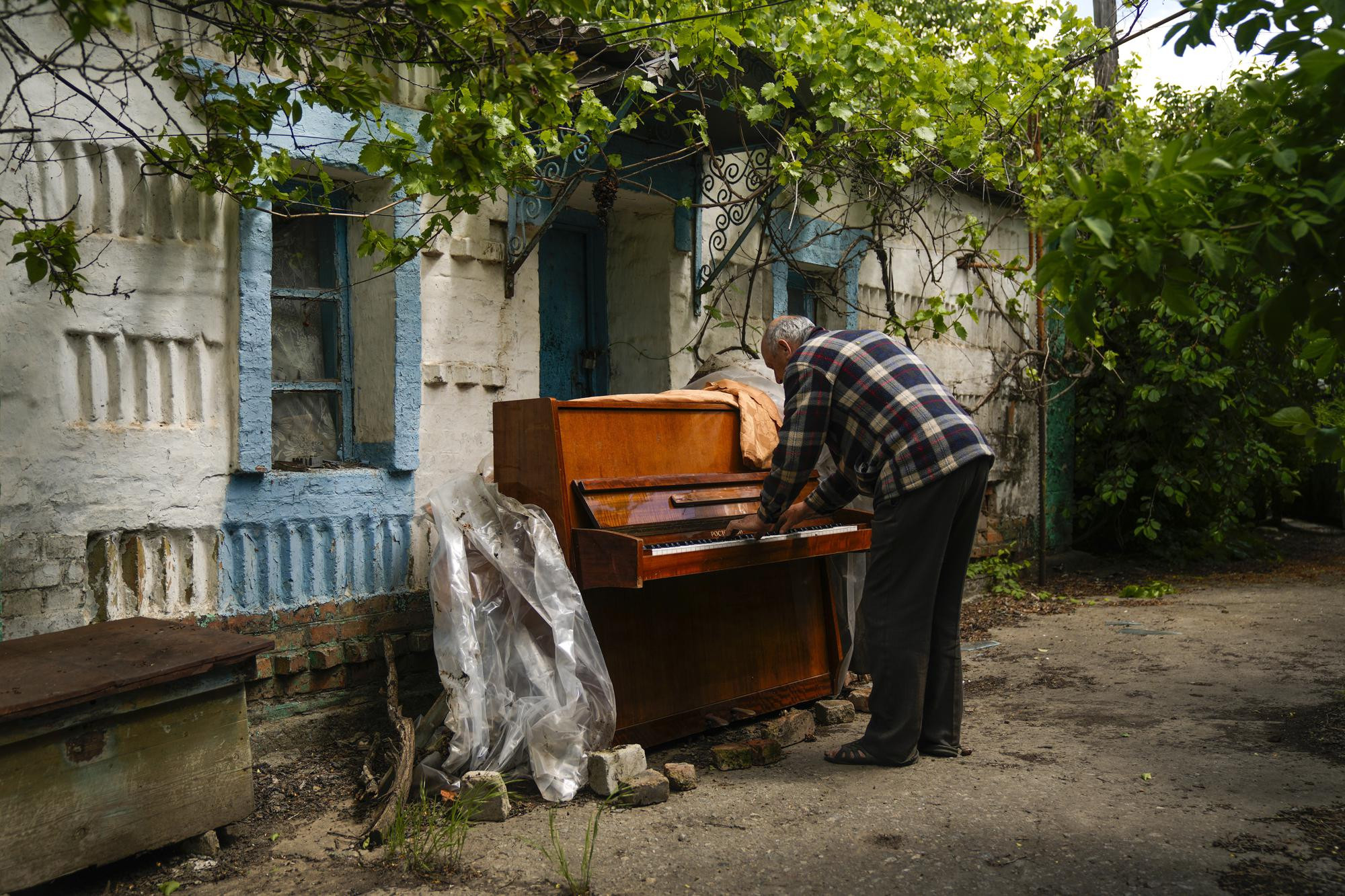 Anatolii Virko plays a piano outside a house likely damaged after a Russian bombing in Velyka Kostromka village, Ukraine, Thursday, May 19, 2022. (AP Photo/Francisco Seco)
Anatolii Virko plays a piano outside a house likely damaged after a Russian bombing in Velyka Kostromka village, Ukraine, Thursday, May 19, 2022. (AP Photo/Francisco Seco)
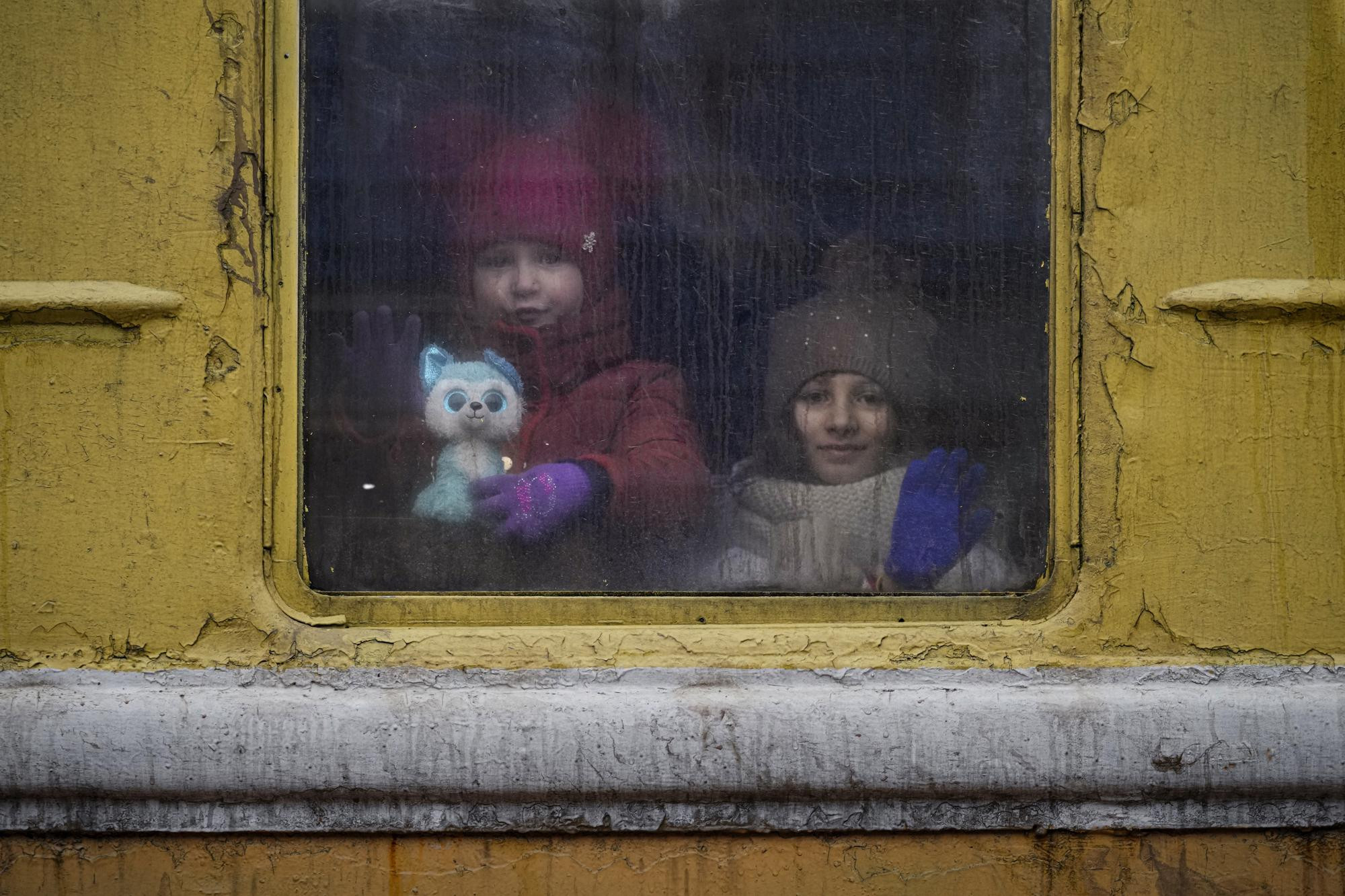 Children look out the window of an unheated Lviv-bound train, in Kyiv, Ukraine, Thursday, March 3, 2022. (AP Photo/Vadim Ghirda)
Children look out the window of an unheated Lviv-bound train, in Kyiv, Ukraine, Thursday, March 3, 2022. (AP Photo/Vadim Ghirda)
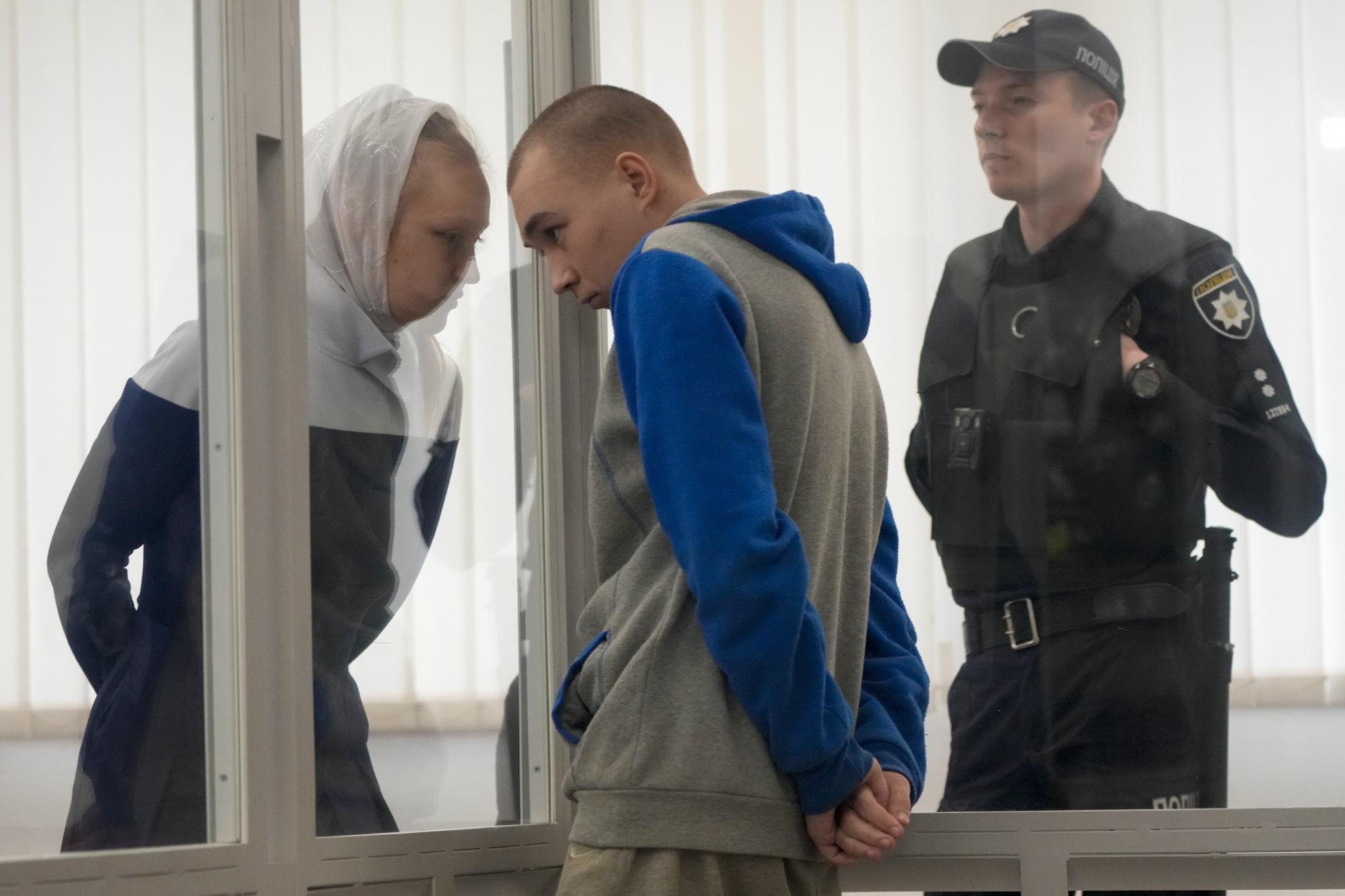 Russian Sgt. Vadim Shishimarin listens to his translator during his court hearing in Kyiv, Ukraine, Monday, May 23, 2022. The 21-year-old soldier facing the first war crimes trial since the start of the war in Ukraine pleaded guilty on May 18 to killing an unarmed civilian. (AP Photo/Natacha Pisarenko)
Russian Sgt. Vadim Shishimarin listens to his translator during his court hearing in Kyiv, Ukraine, Monday, May 23, 2022. The 21-year-old soldier facing the first war crimes trial since the start of the war in Ukraine pleaded guilty on May 18 to killing an unarmed civilian. (AP Photo/Natacha Pisarenko)
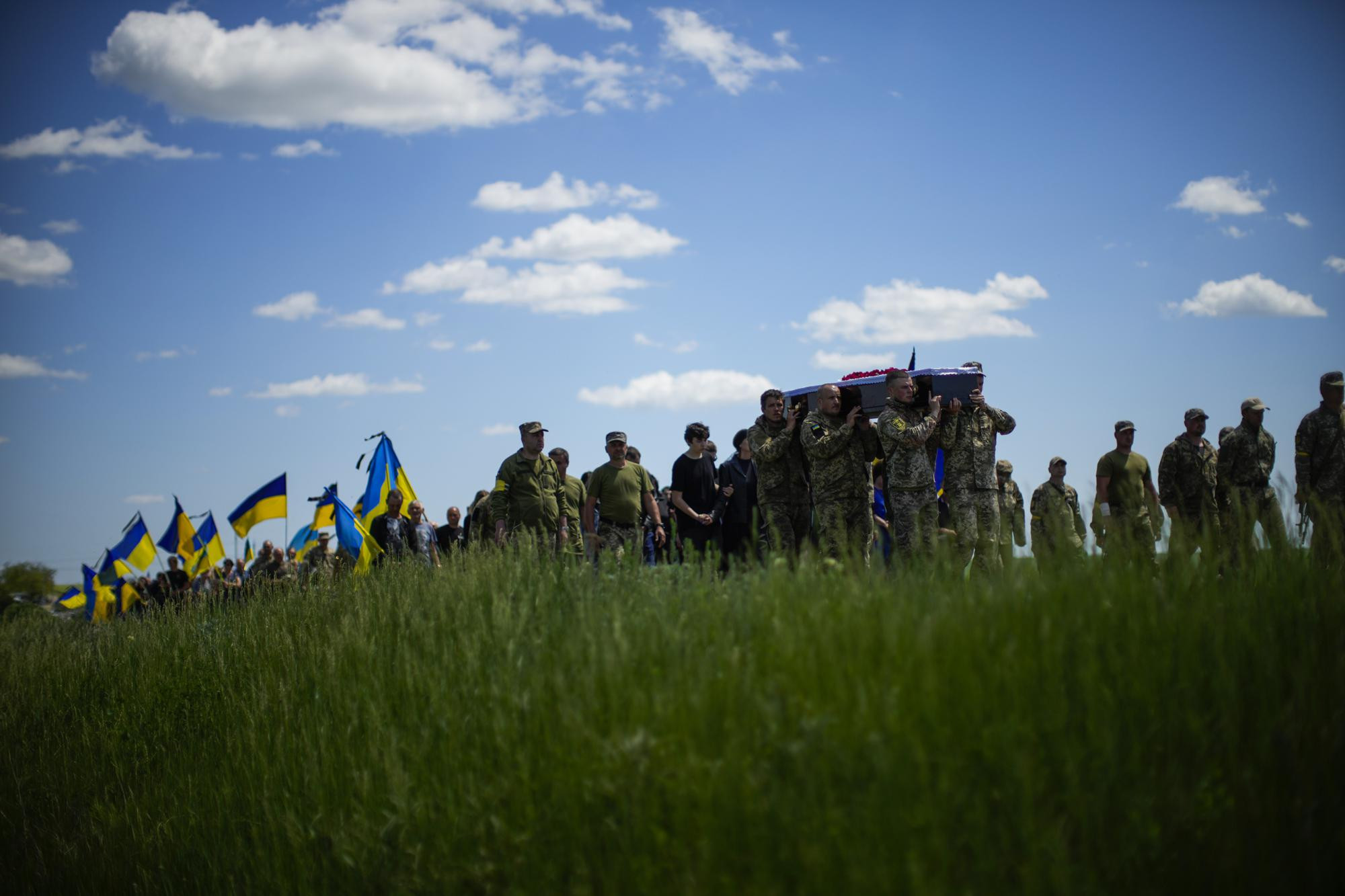 Ukrainian soldiers carry the coffin of Volodymyr Losev, 38, during his funeral in Zorya Truda in the Odesa region of Ukraine, Monday, May 16, 2022. The 38-year-old Ukrainian volunteer soldier was killed May 7 when the military vehicle he was driving ran over a mine in eastern Ukraine. (AP Photo/Francisco Seco)
Ukrainian soldiers carry the coffin of Volodymyr Losev, 38, during his funeral in Zorya Truda in the Odesa region of Ukraine, Monday, May 16, 2022. The 38-year-old Ukrainian volunteer soldier was killed May 7 when the military vehicle he was driving ran over a mine in eastern Ukraine. (AP Photo/Francisco Seco)
